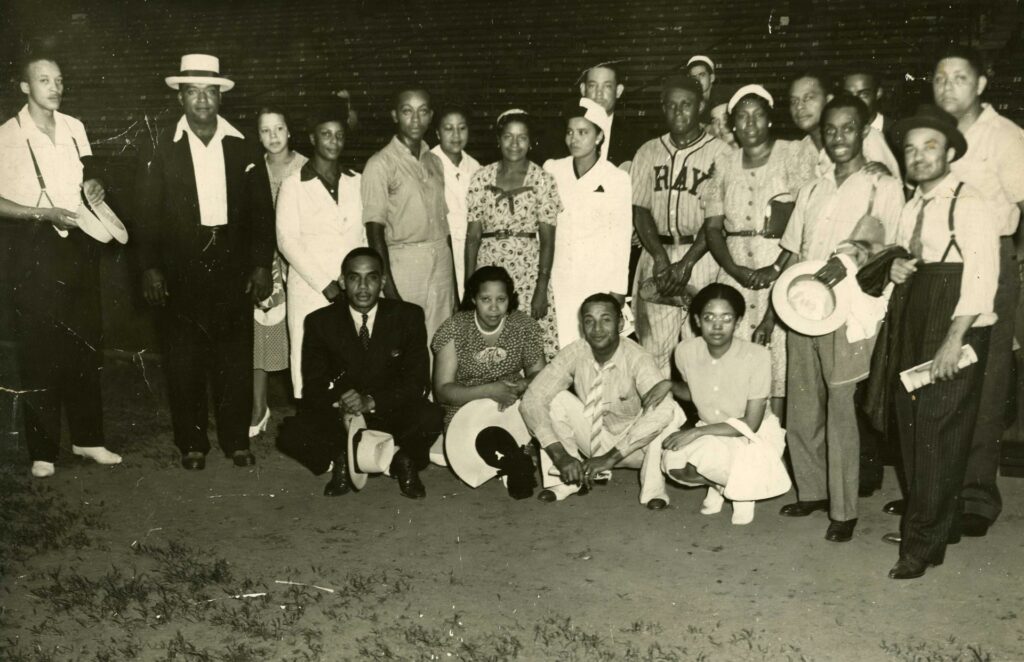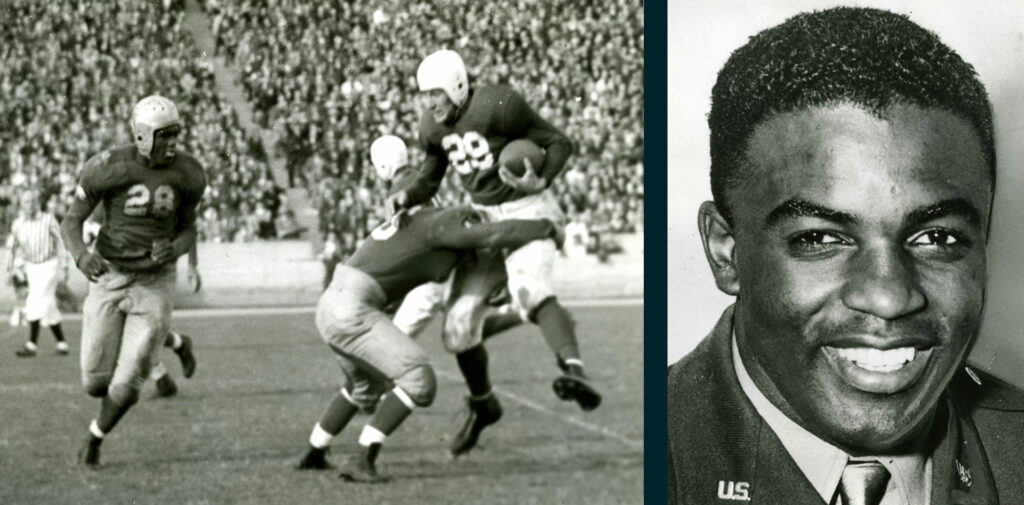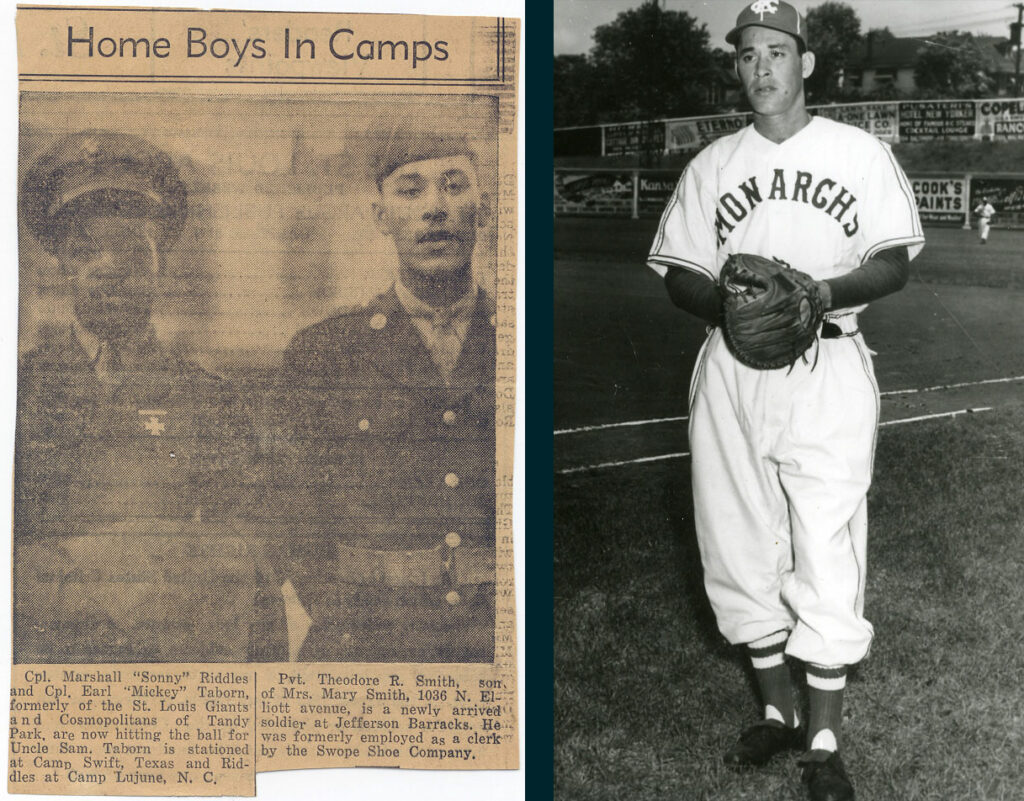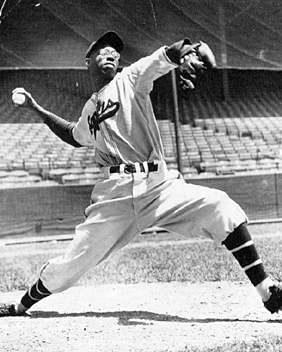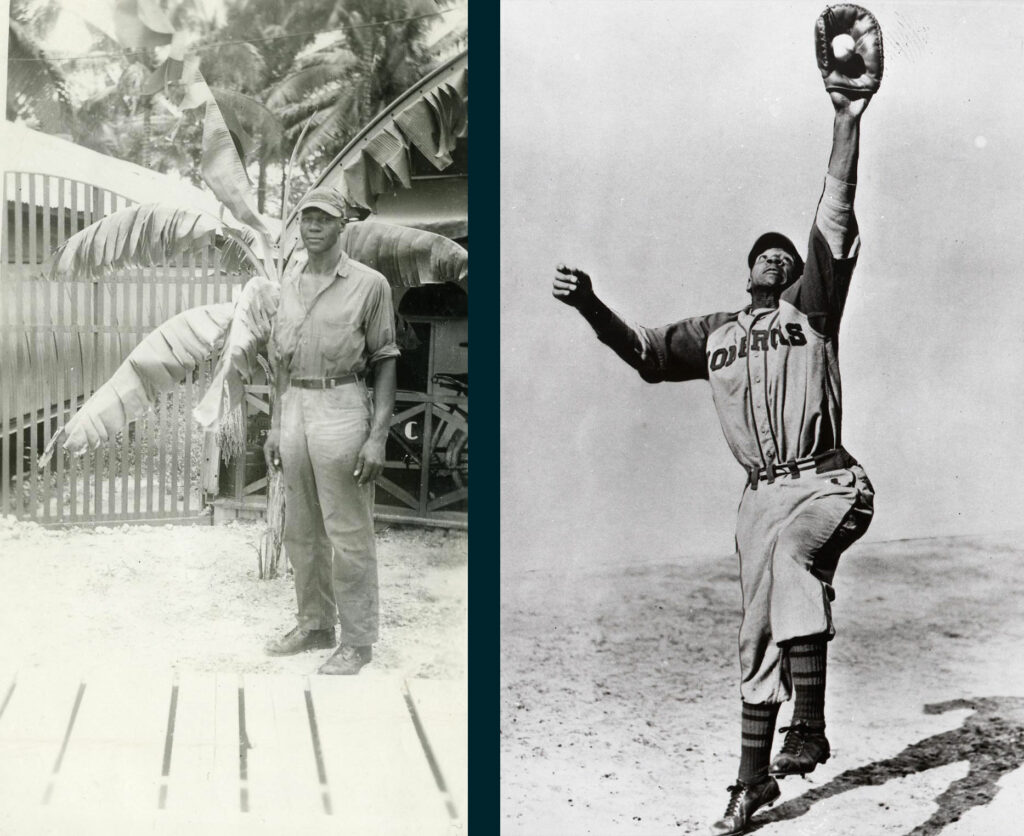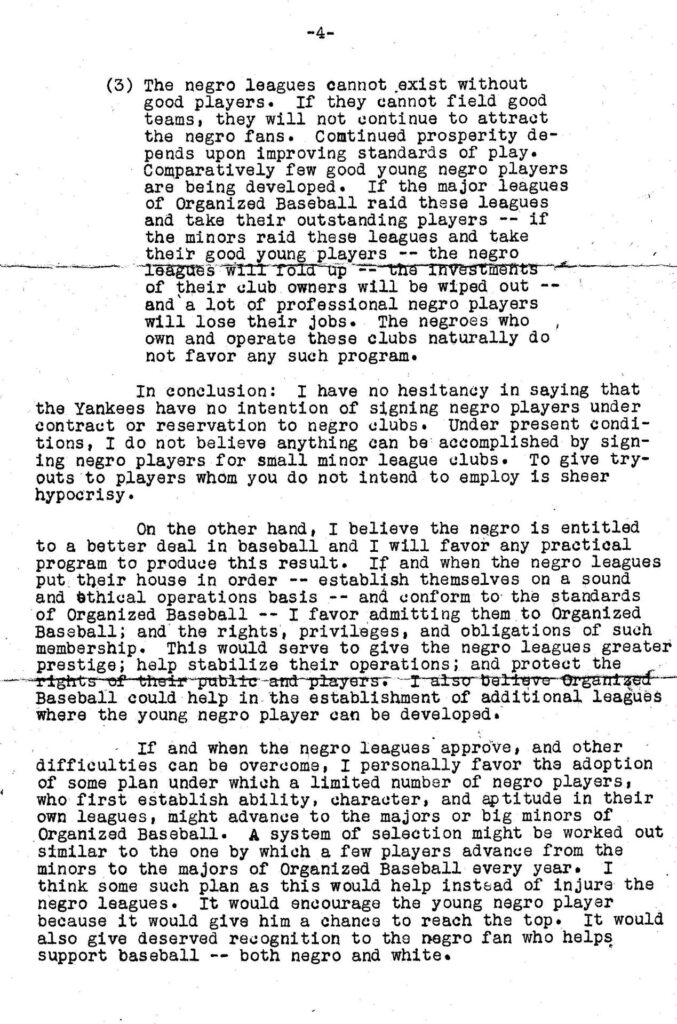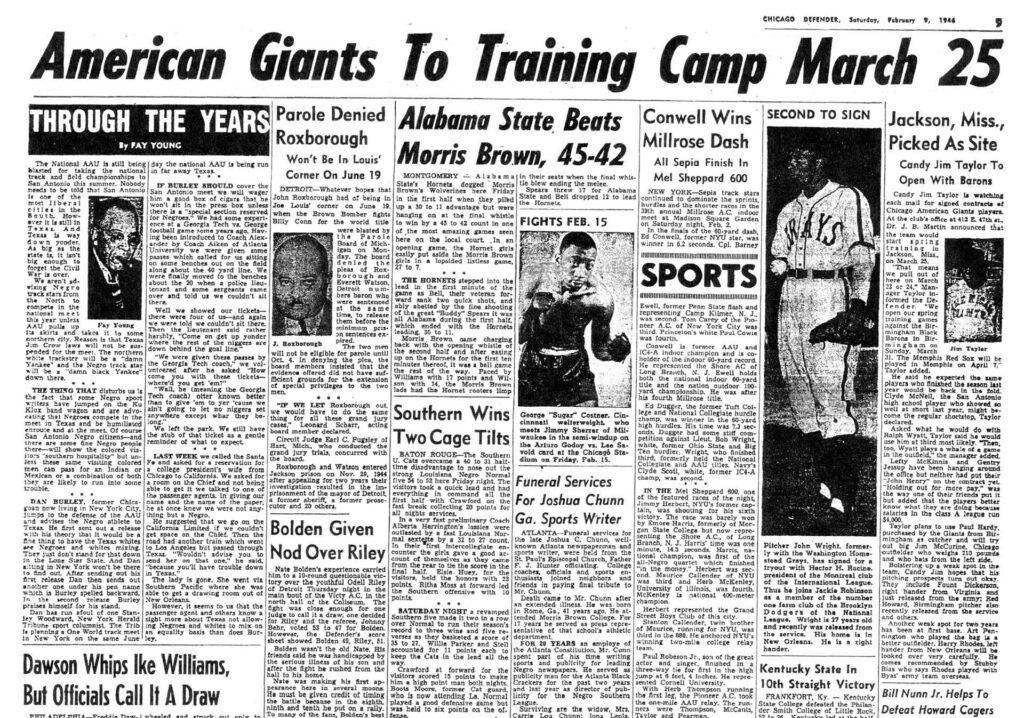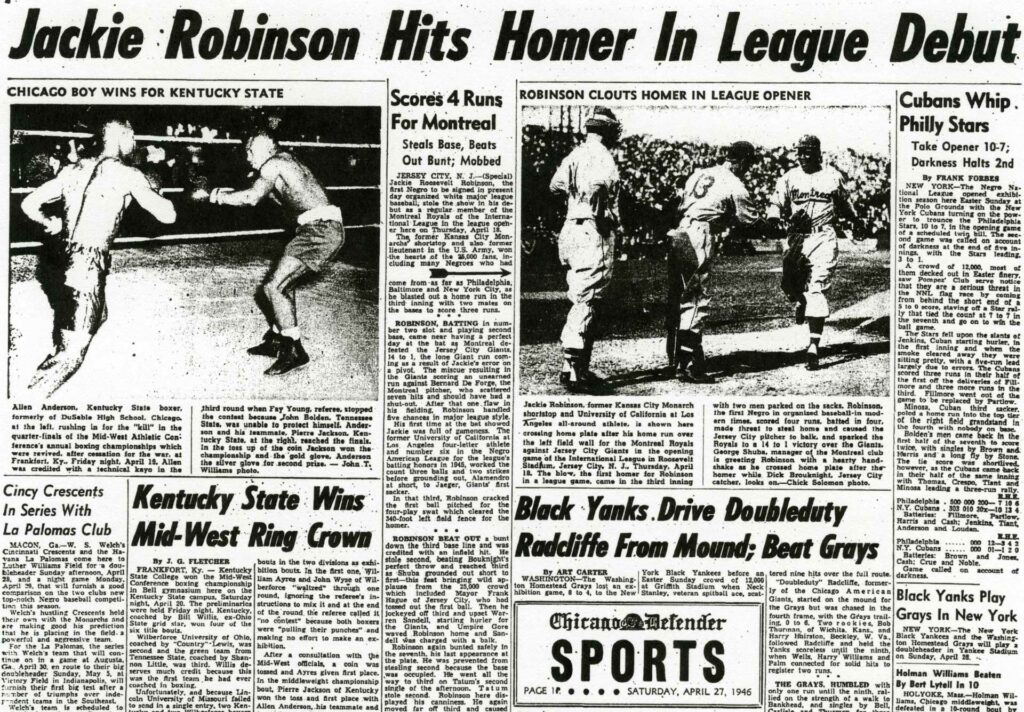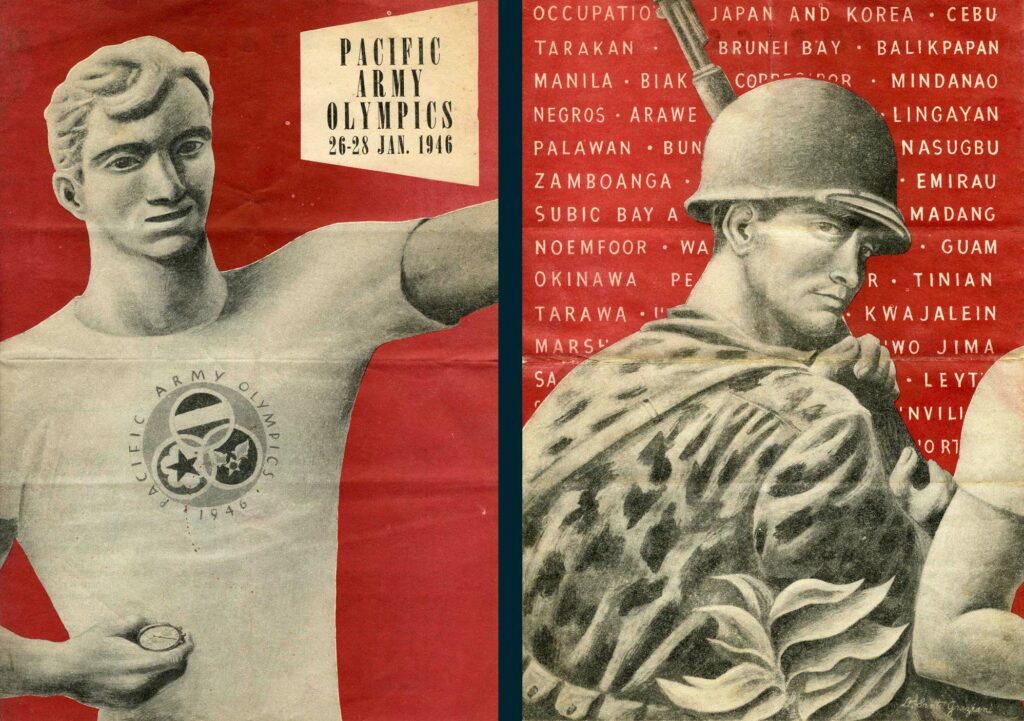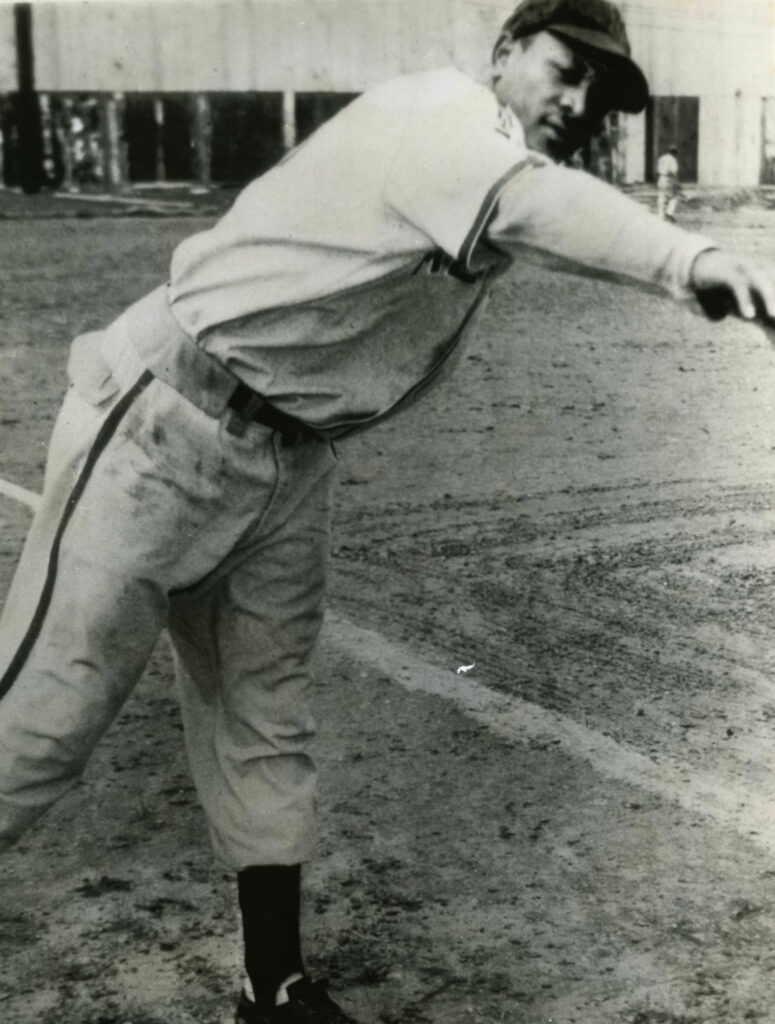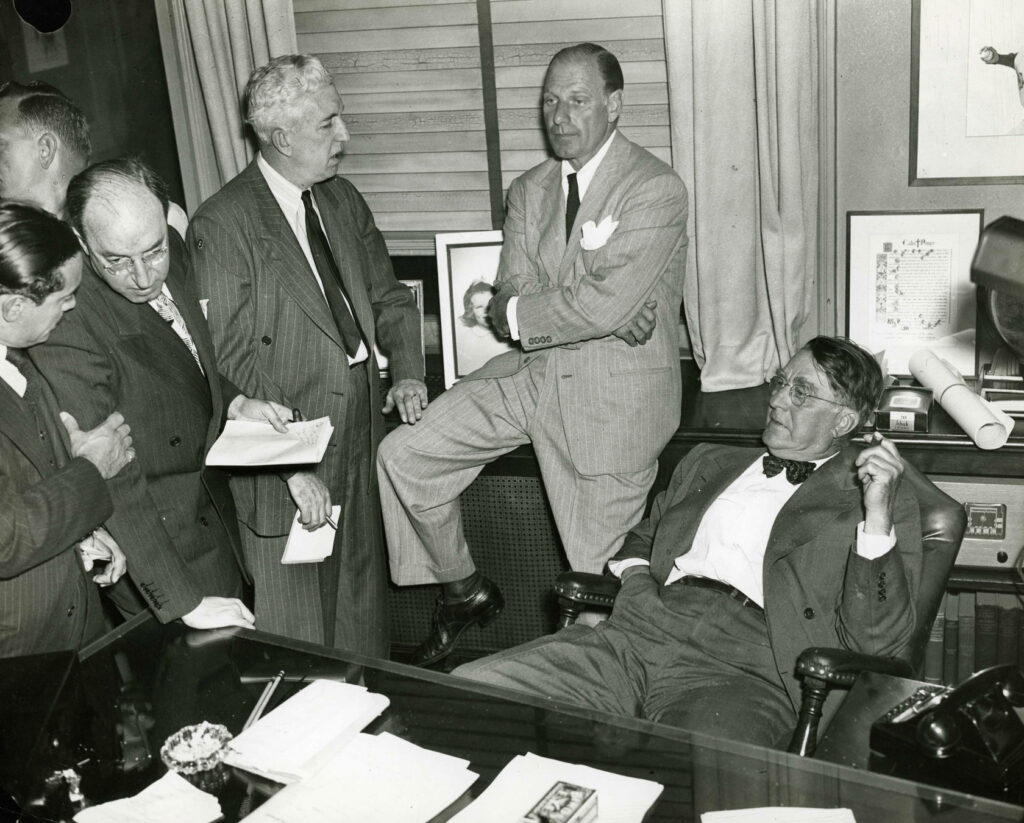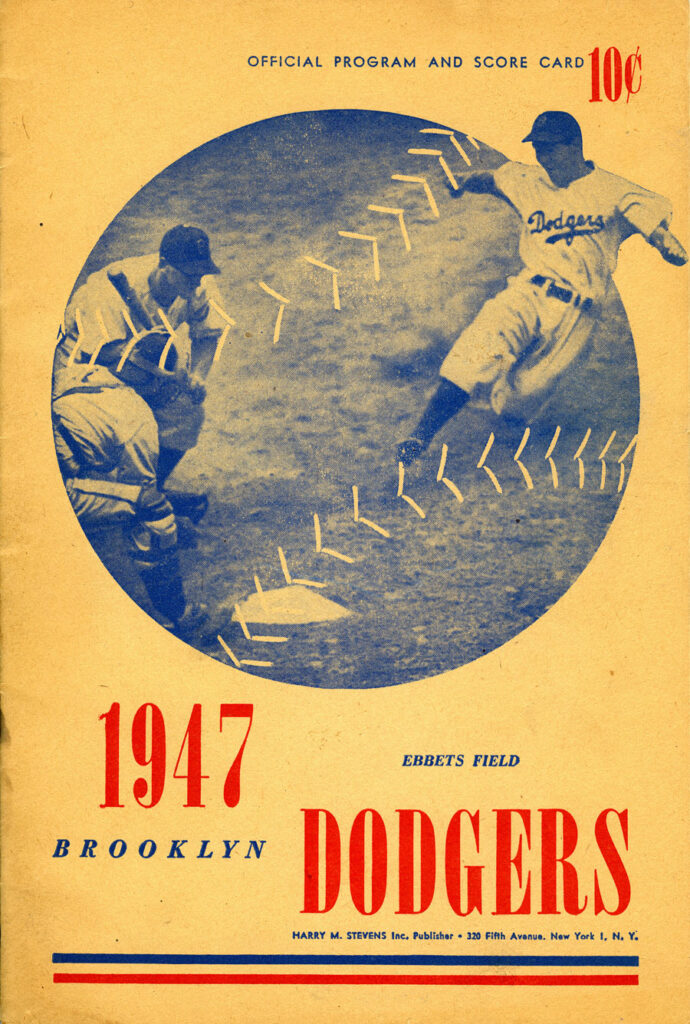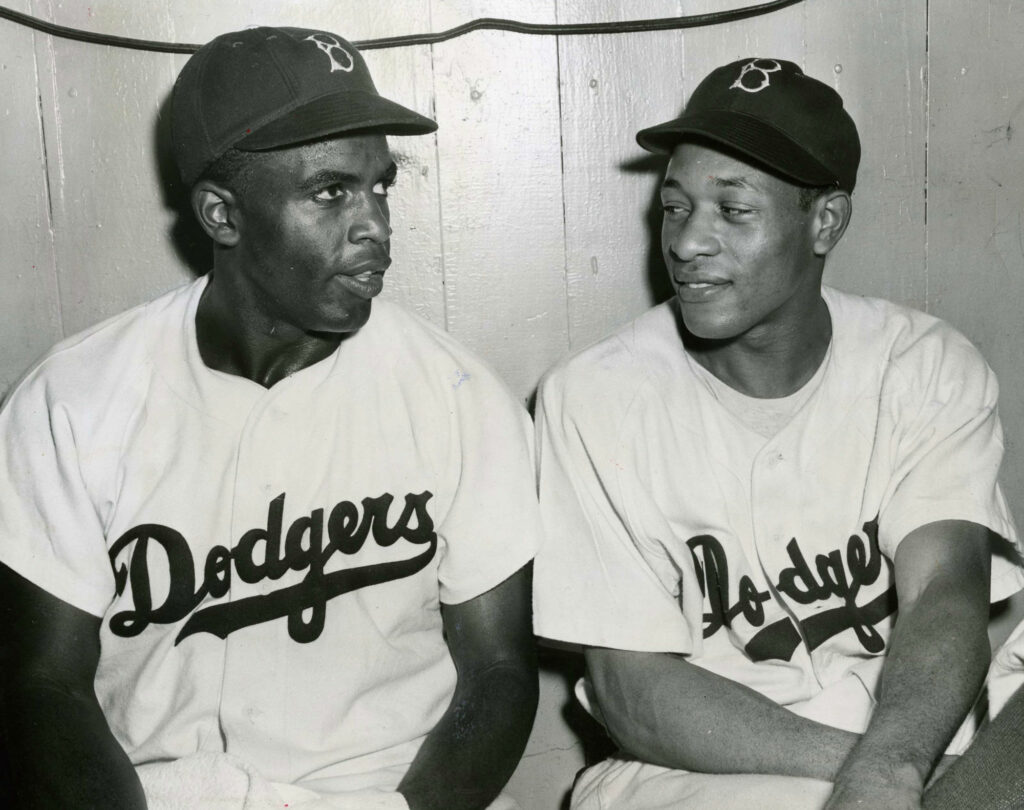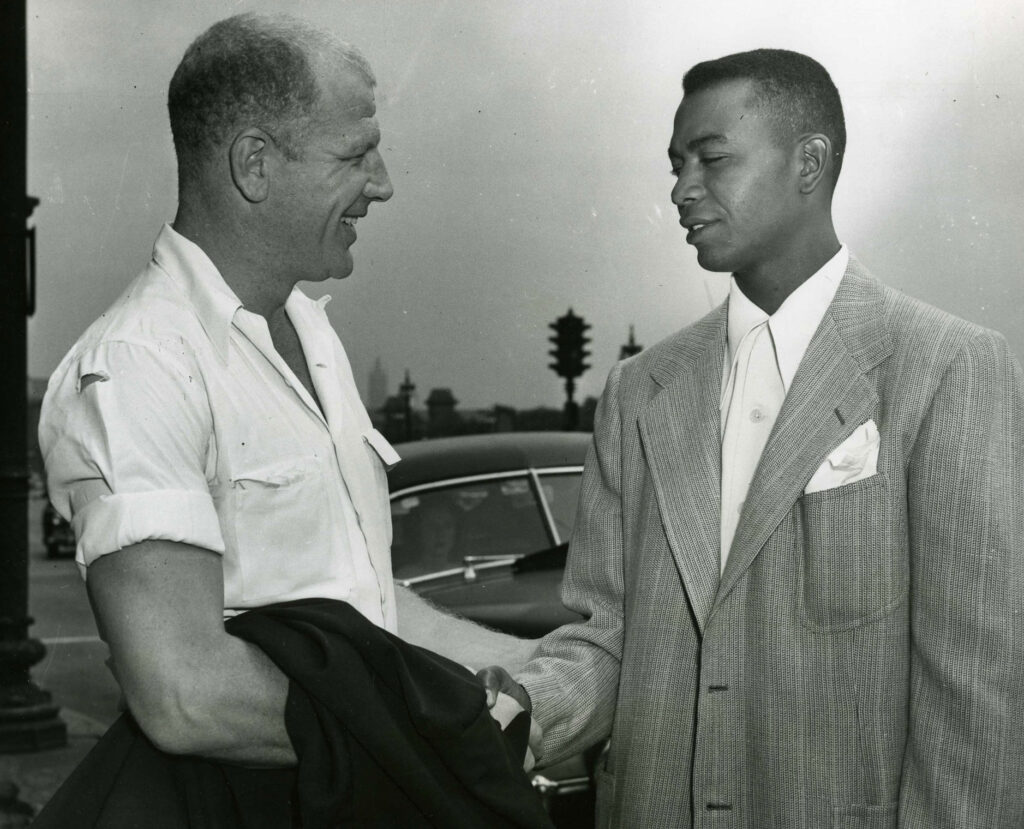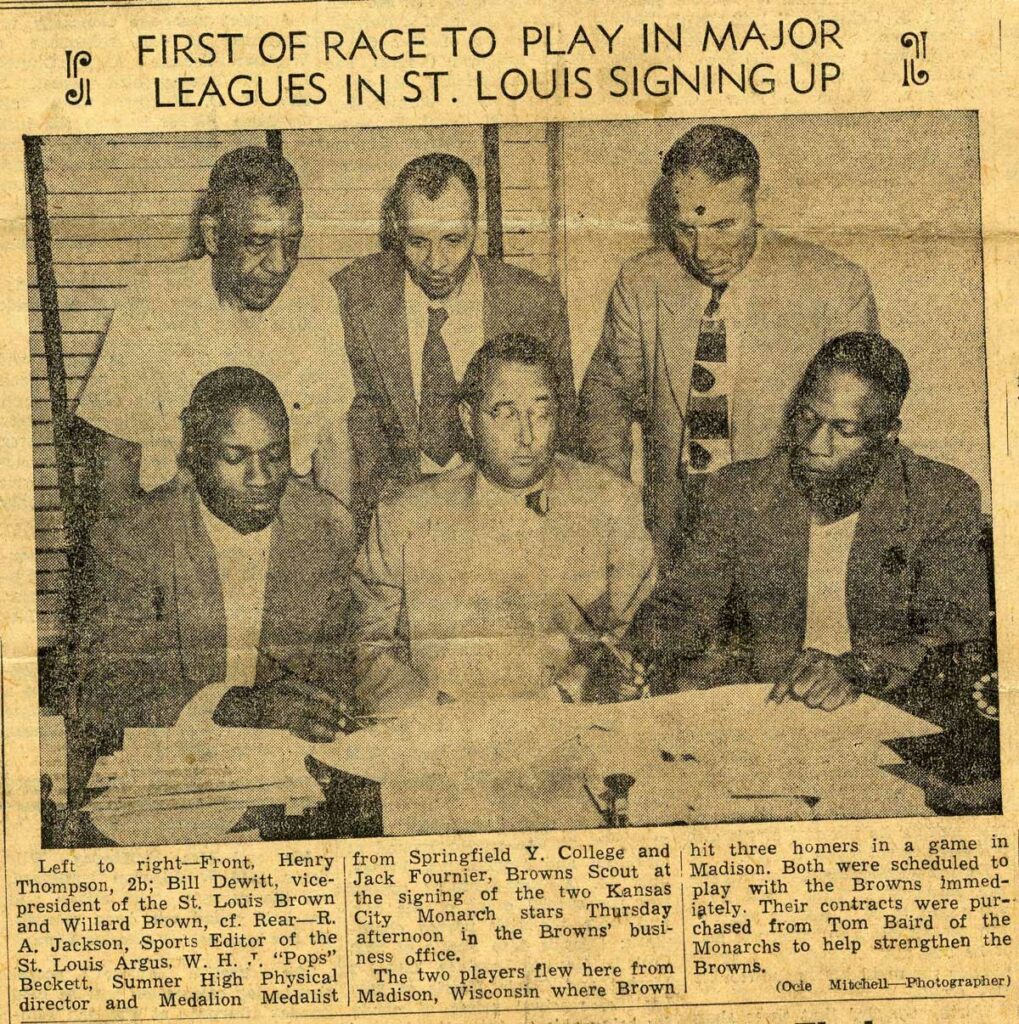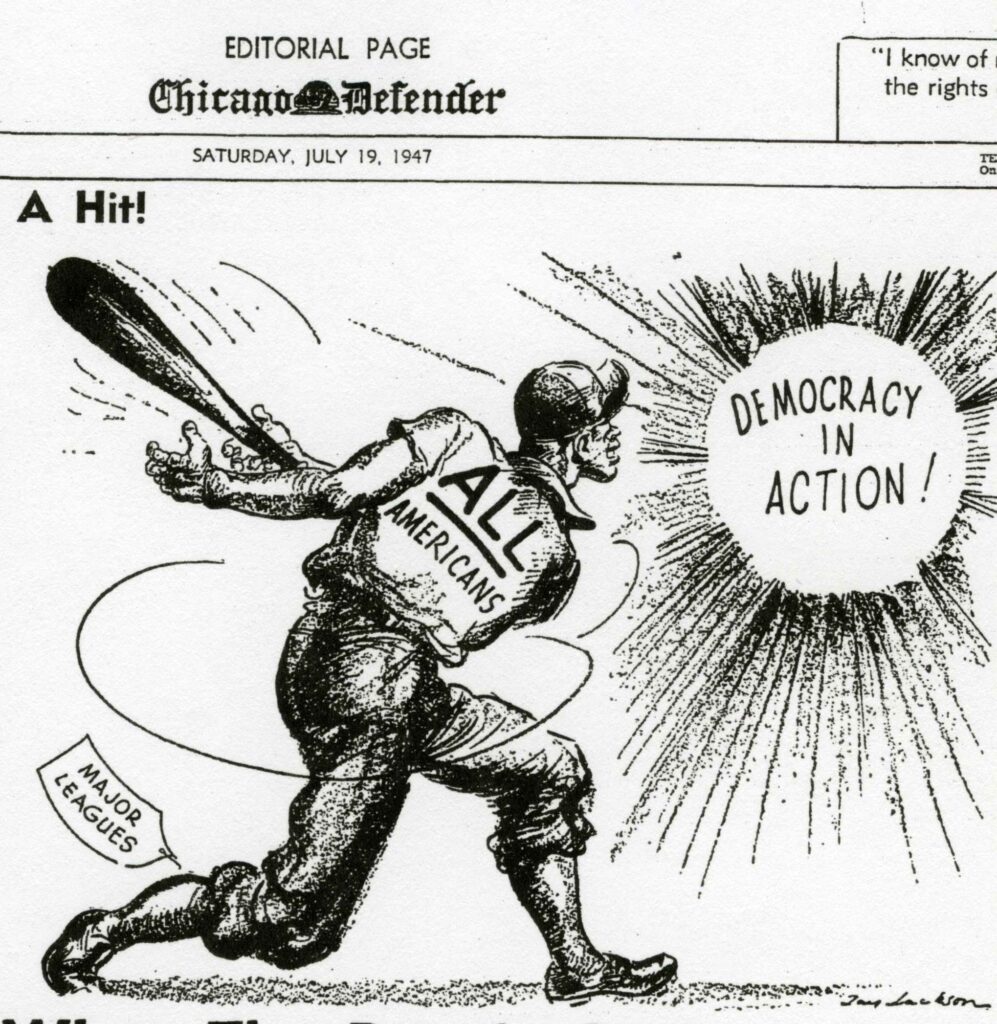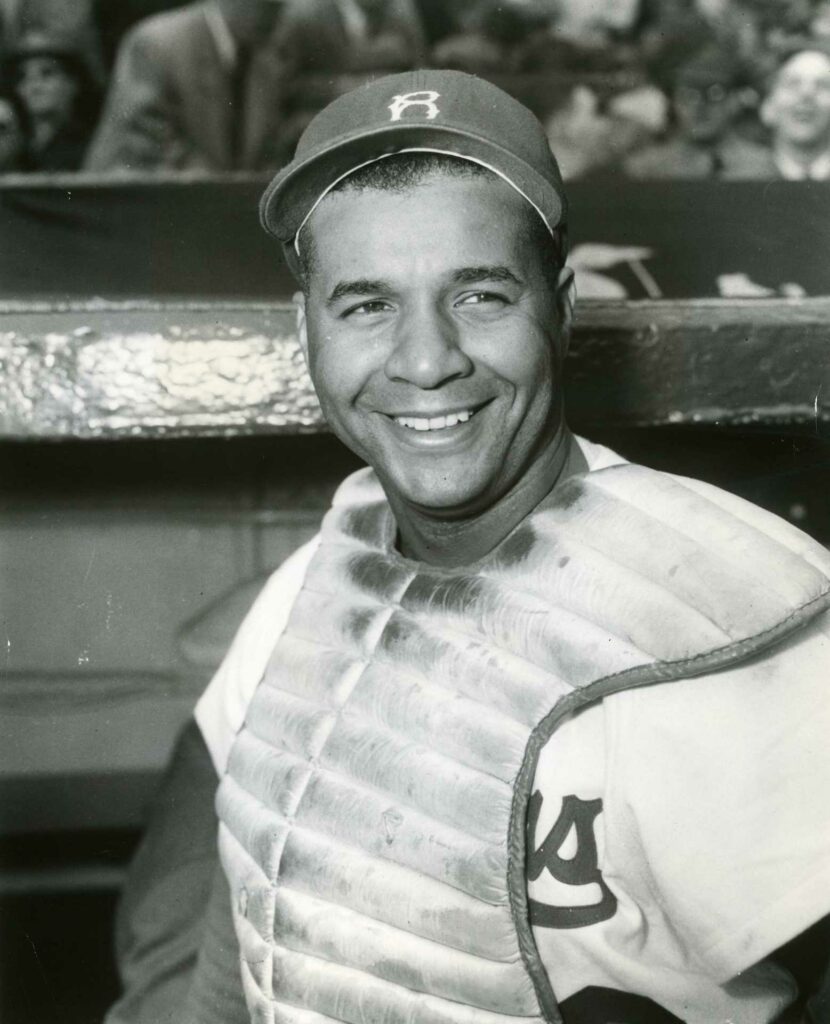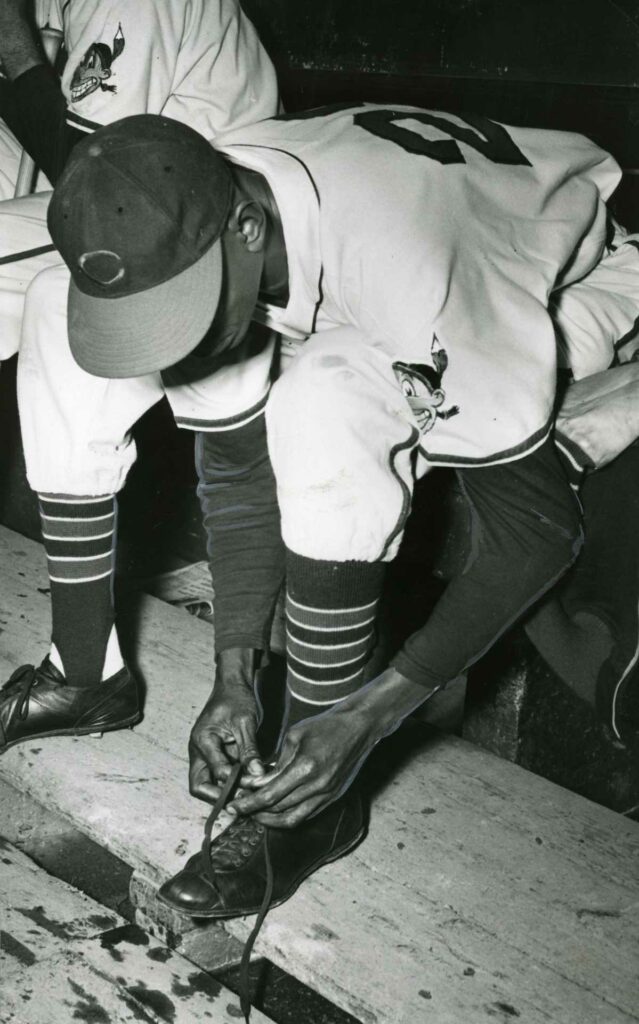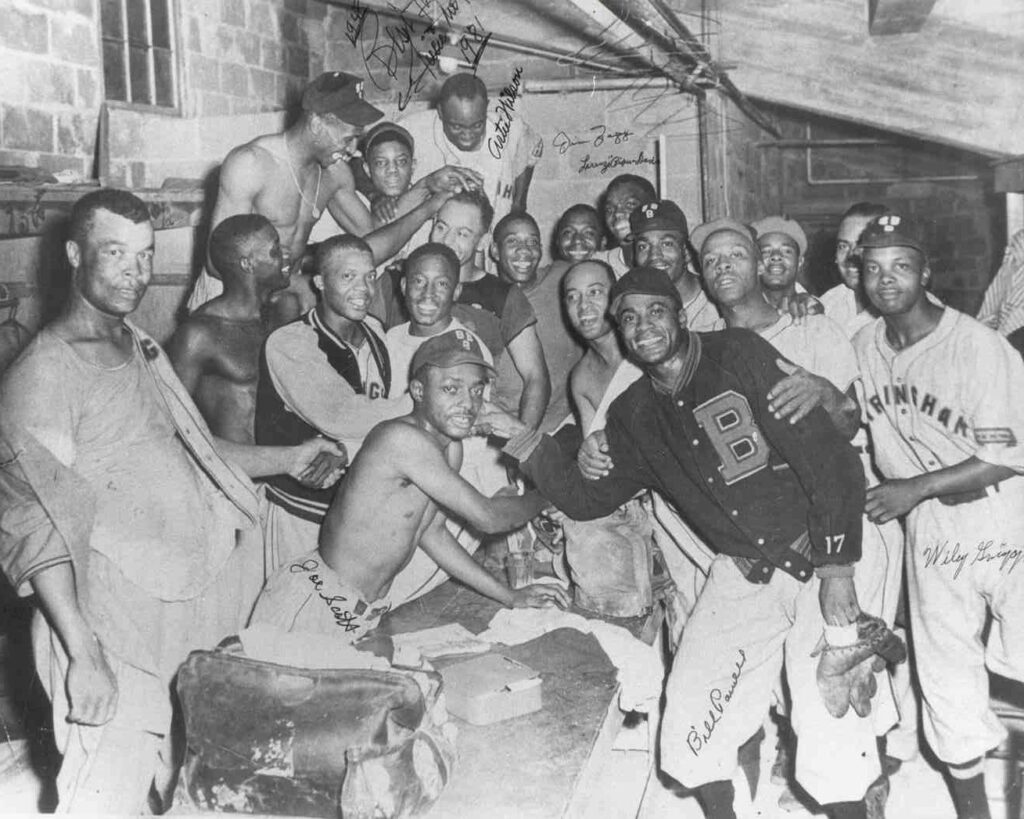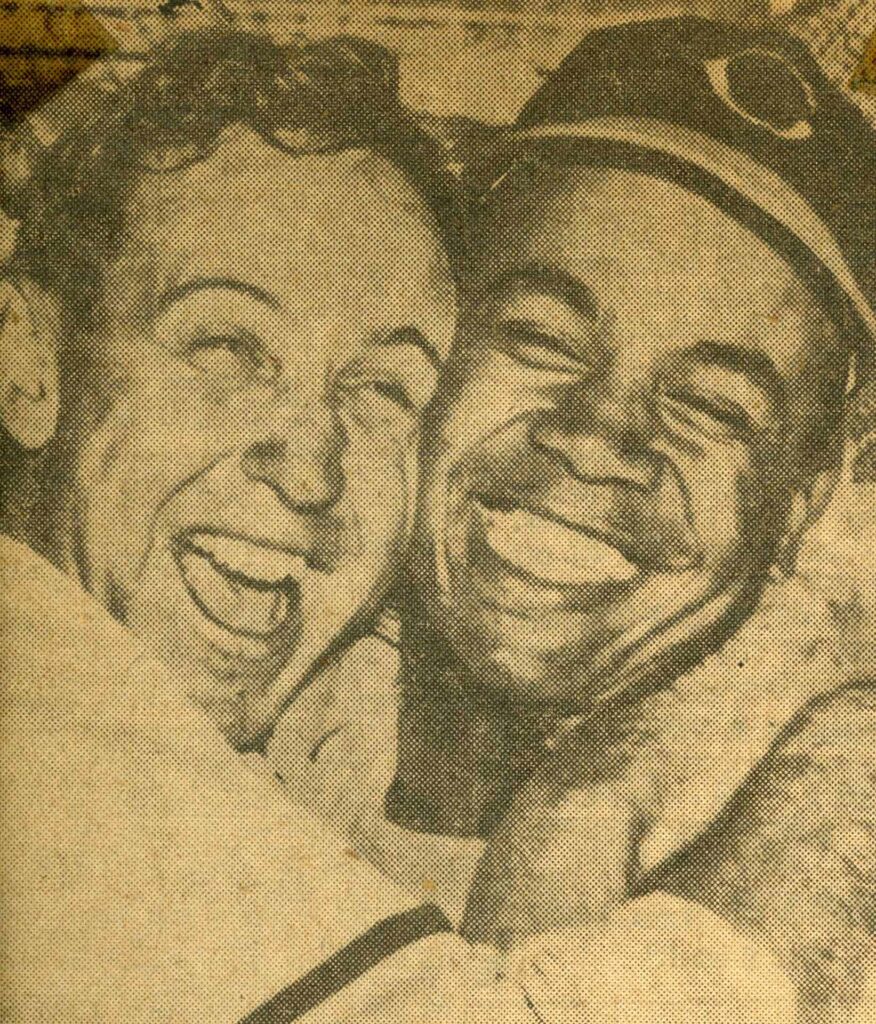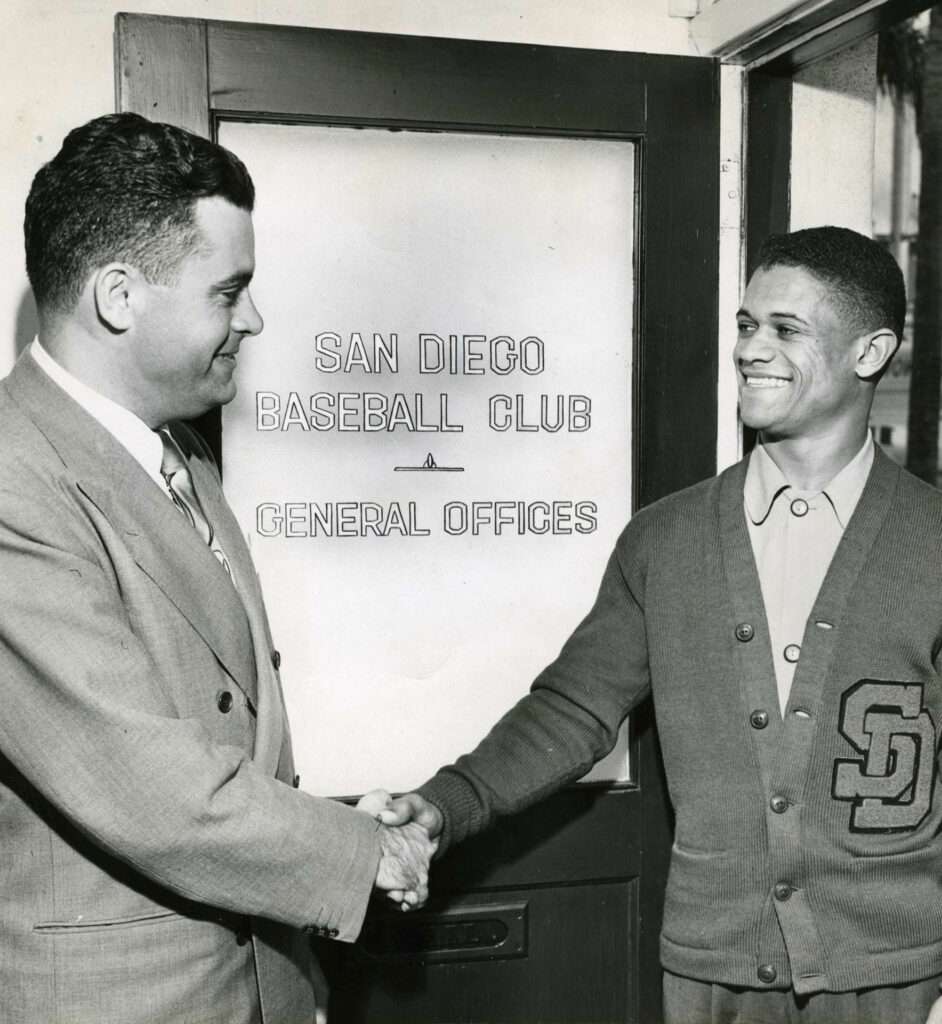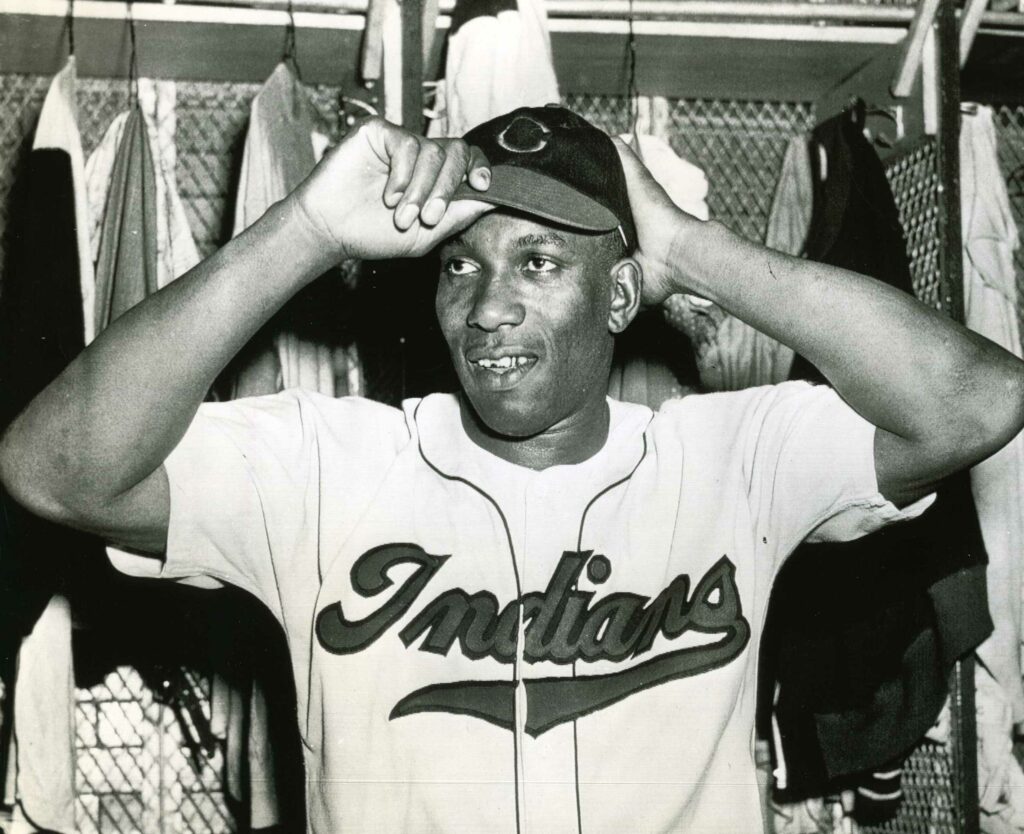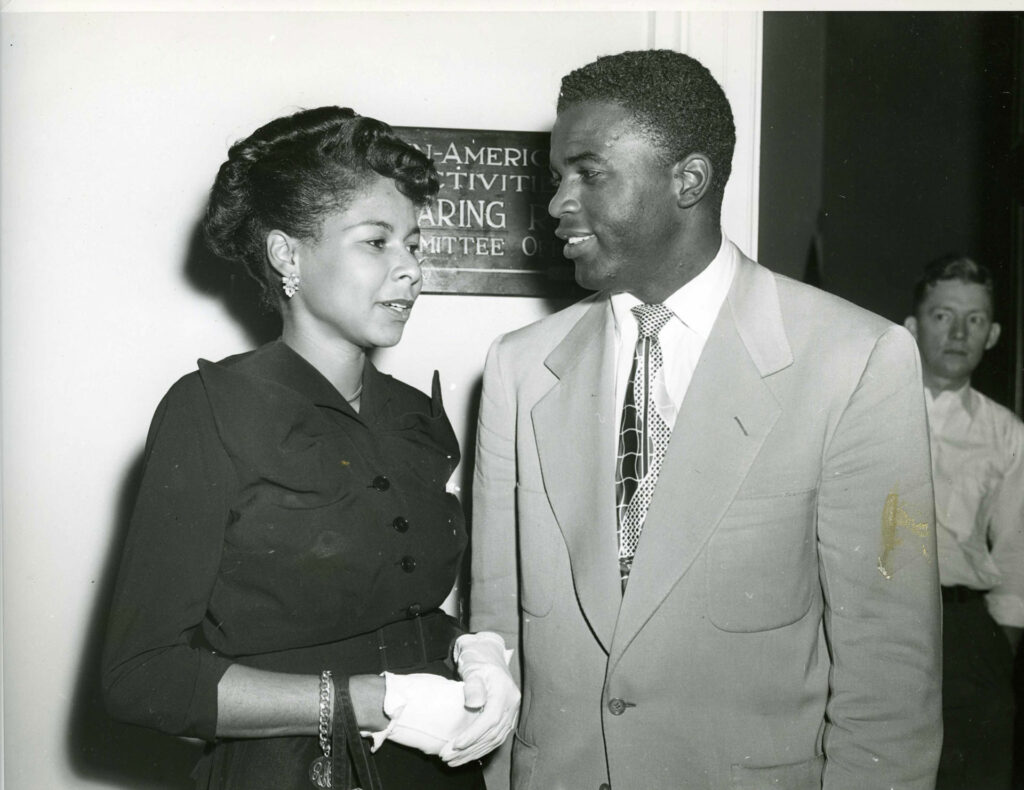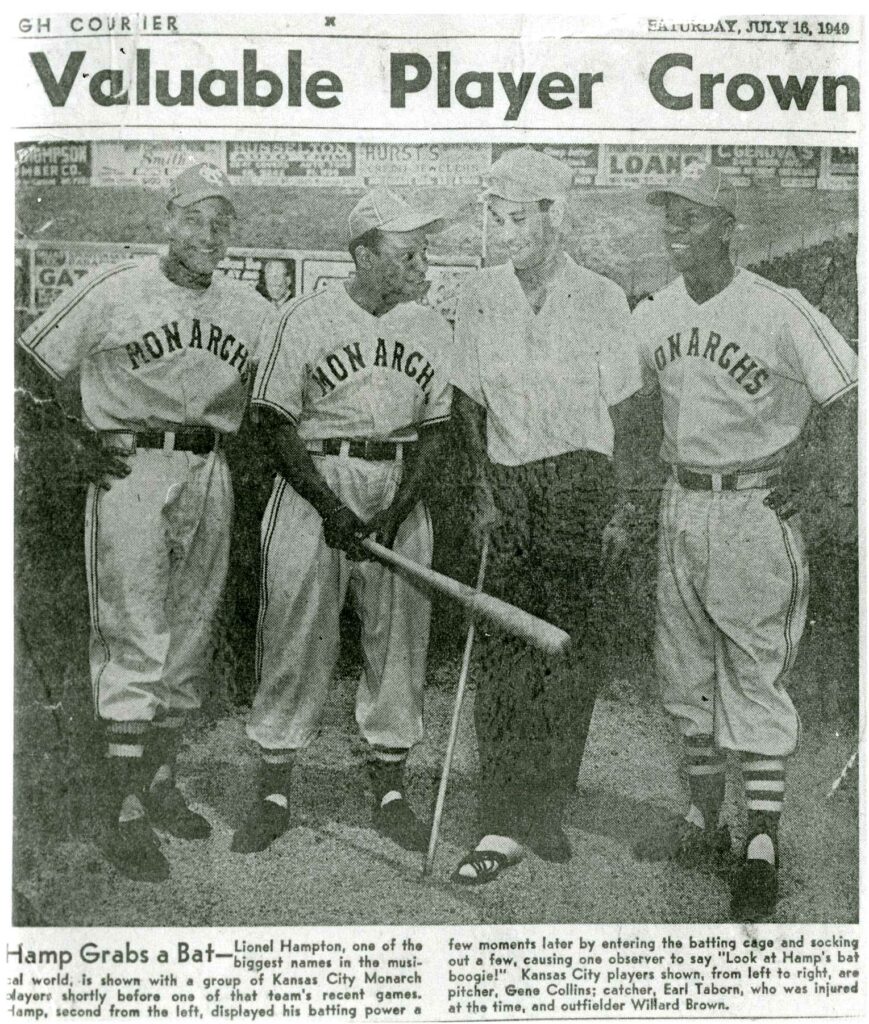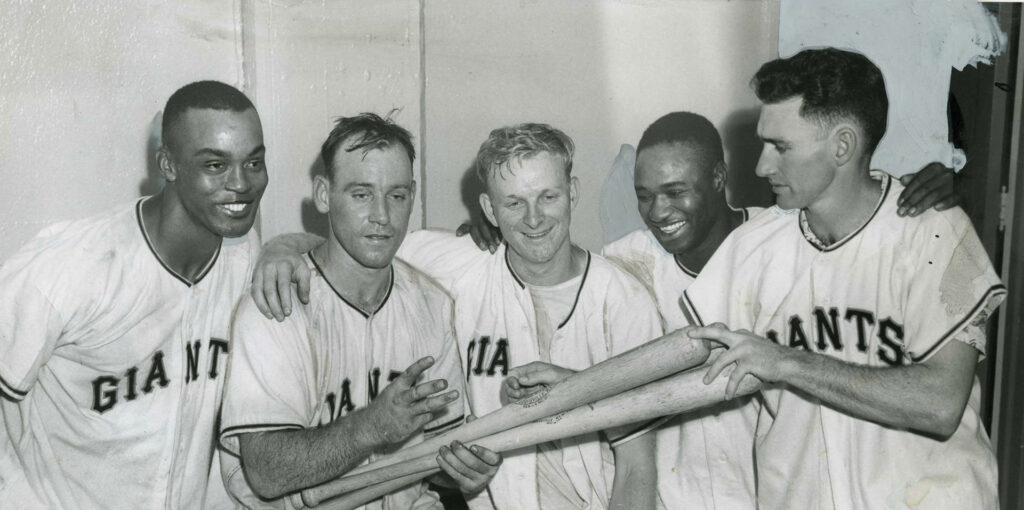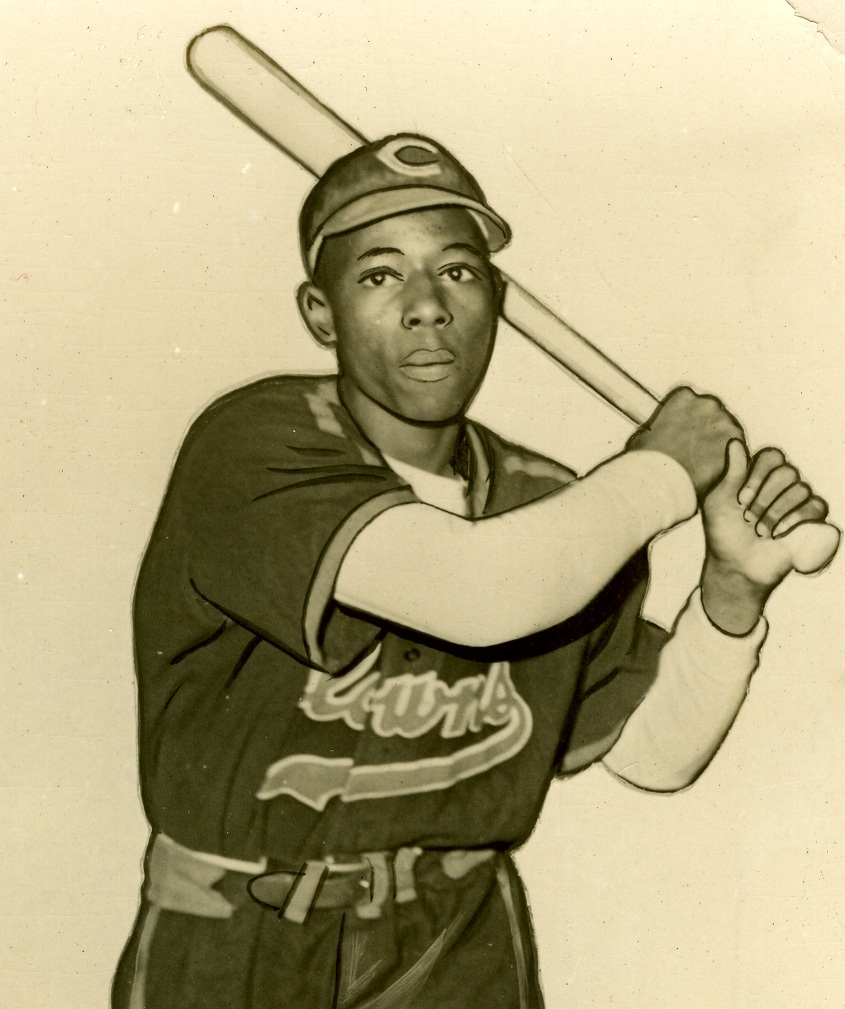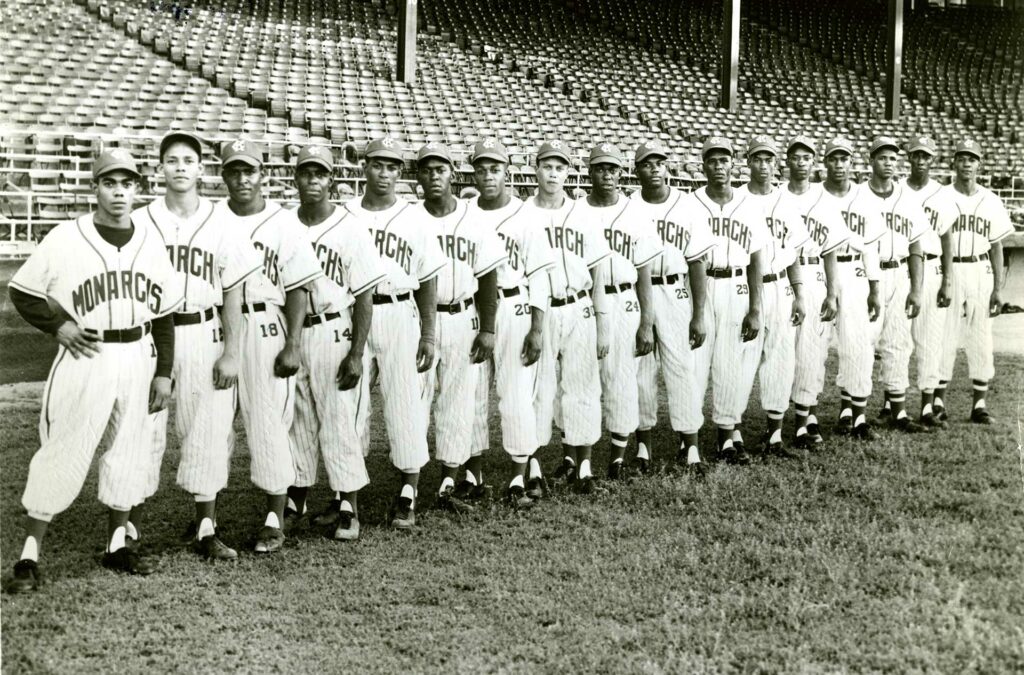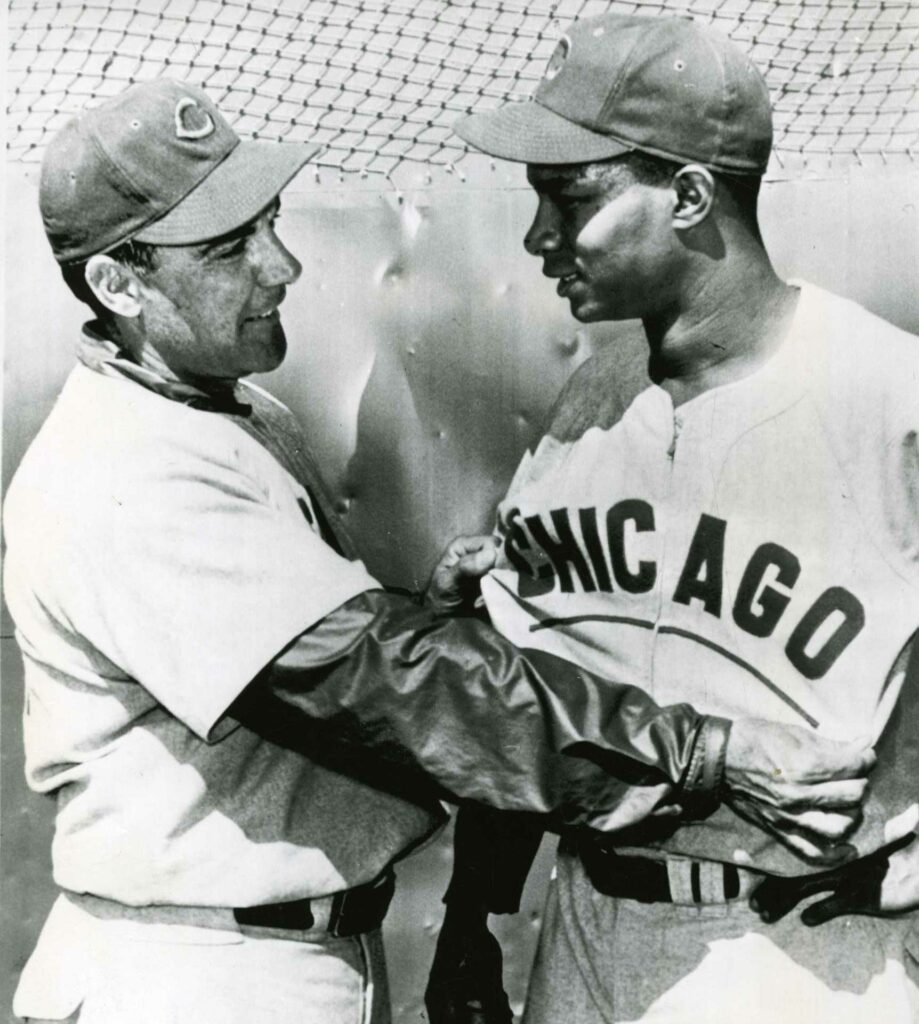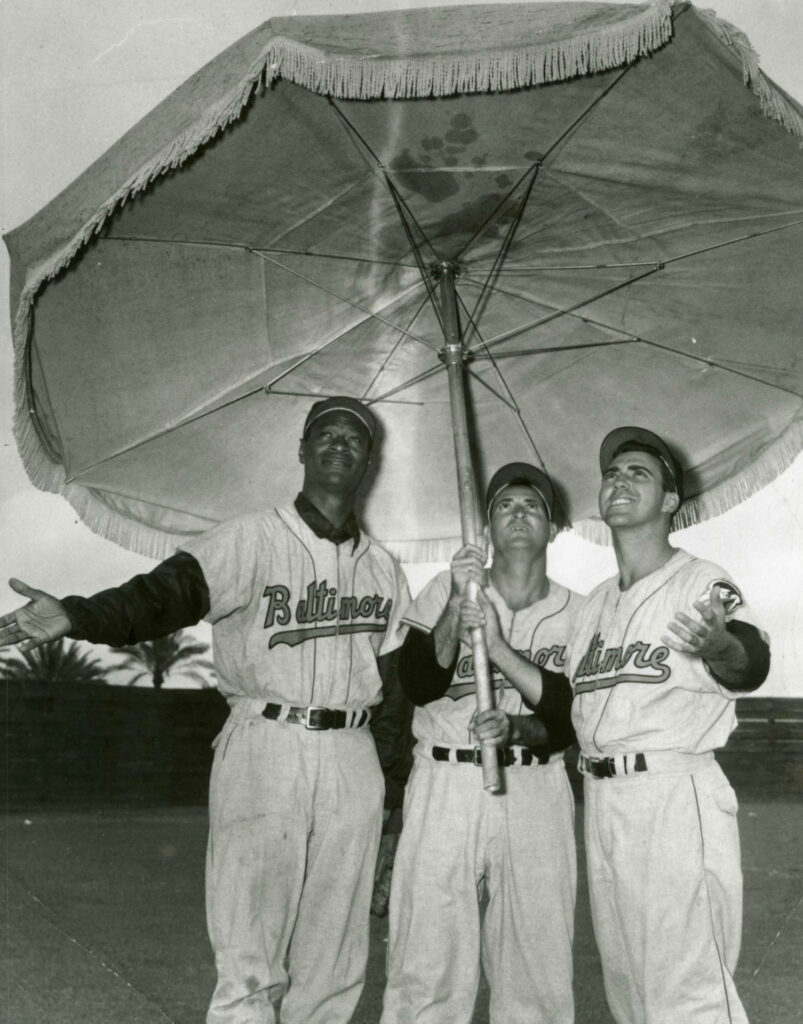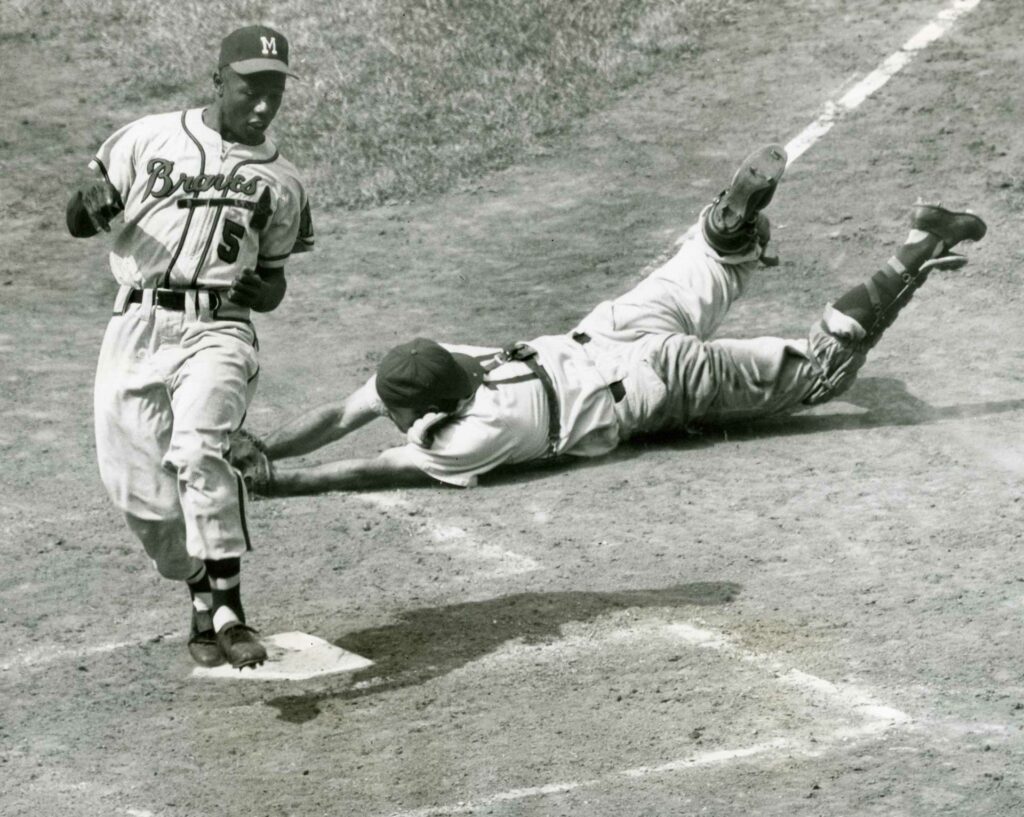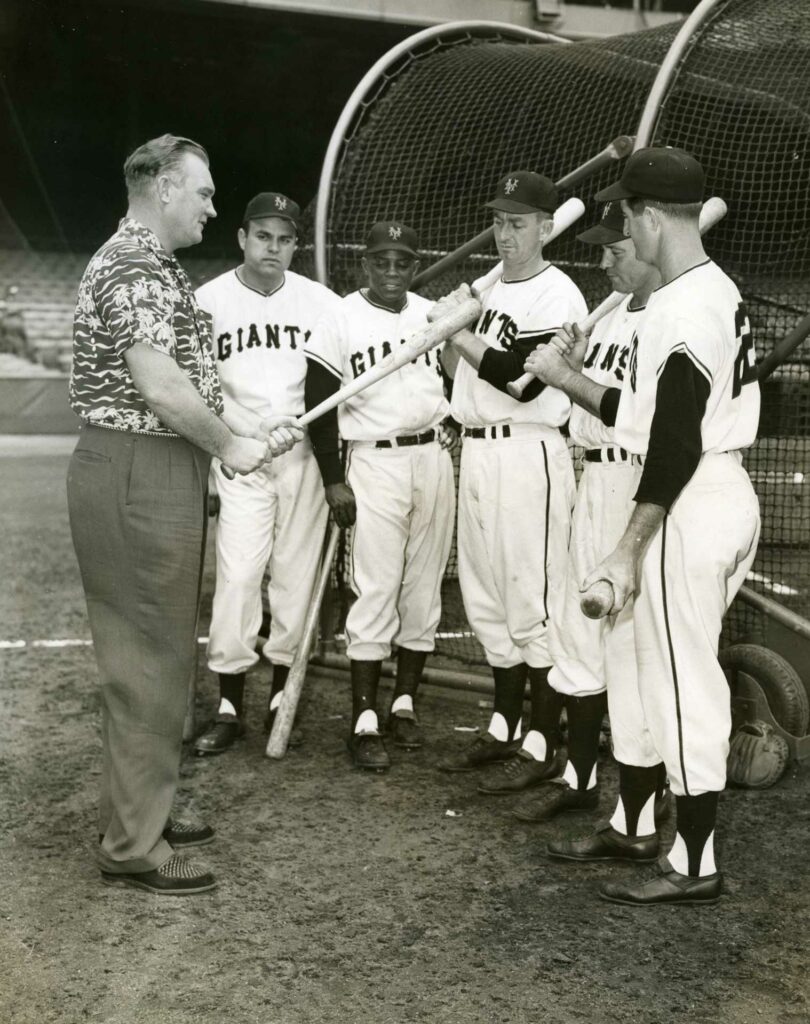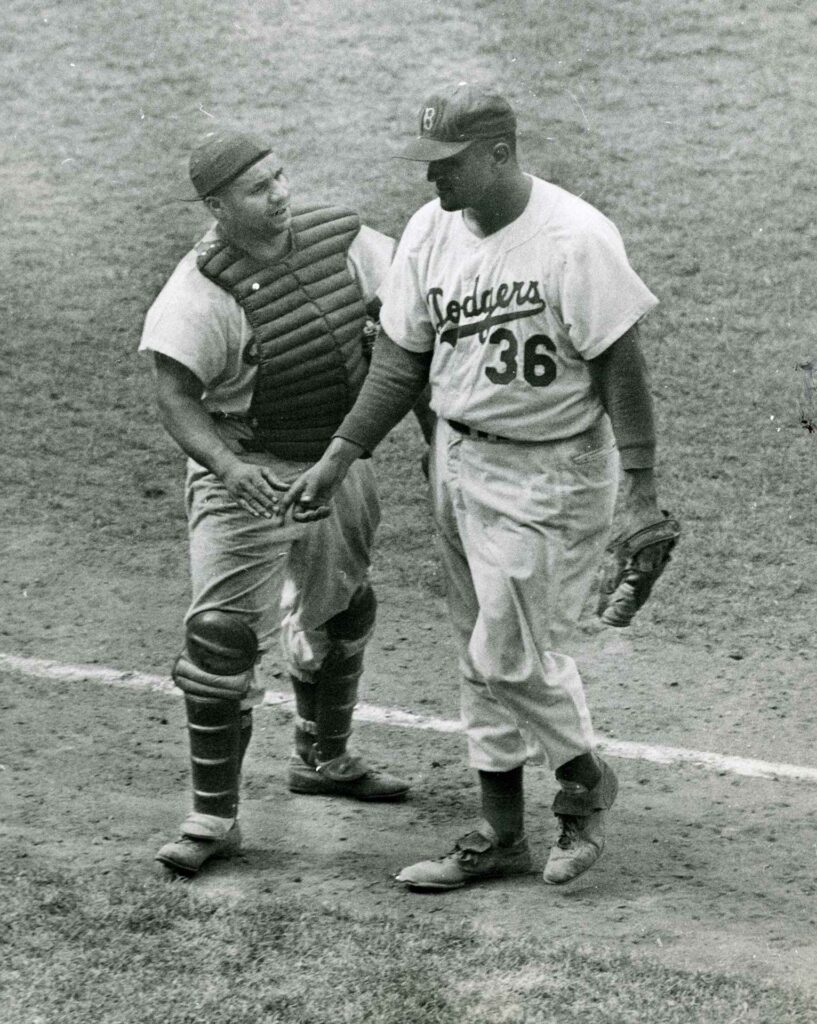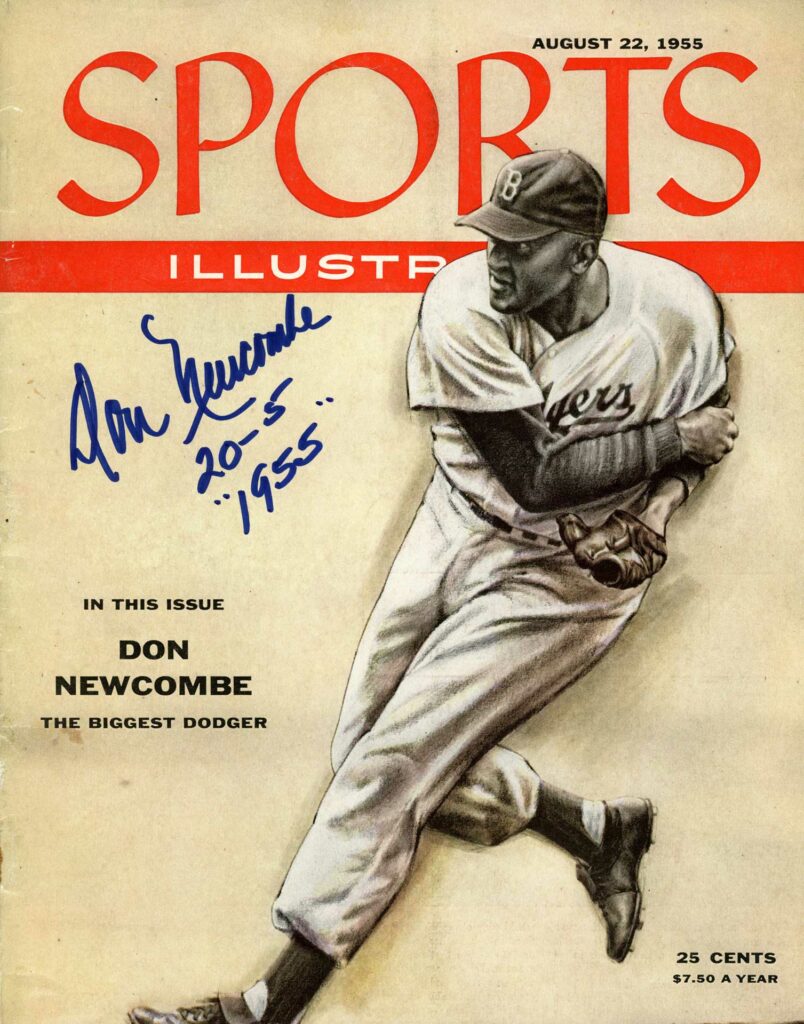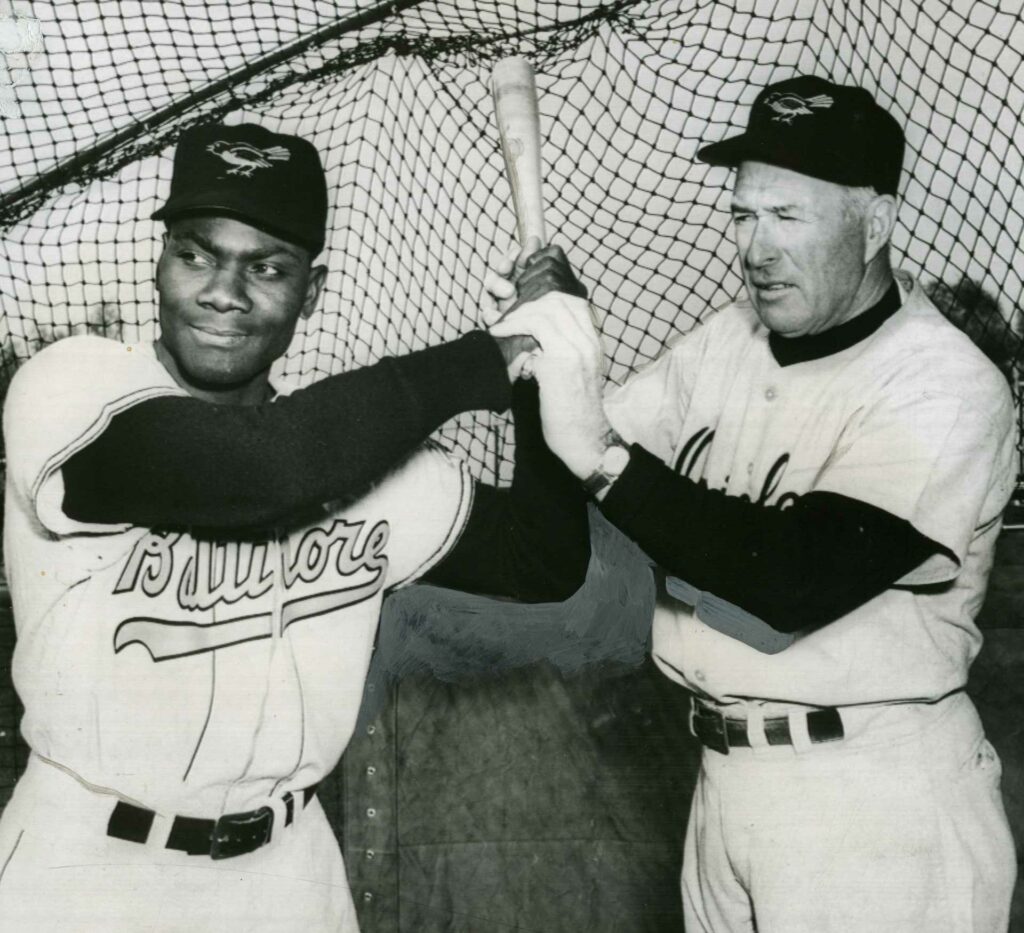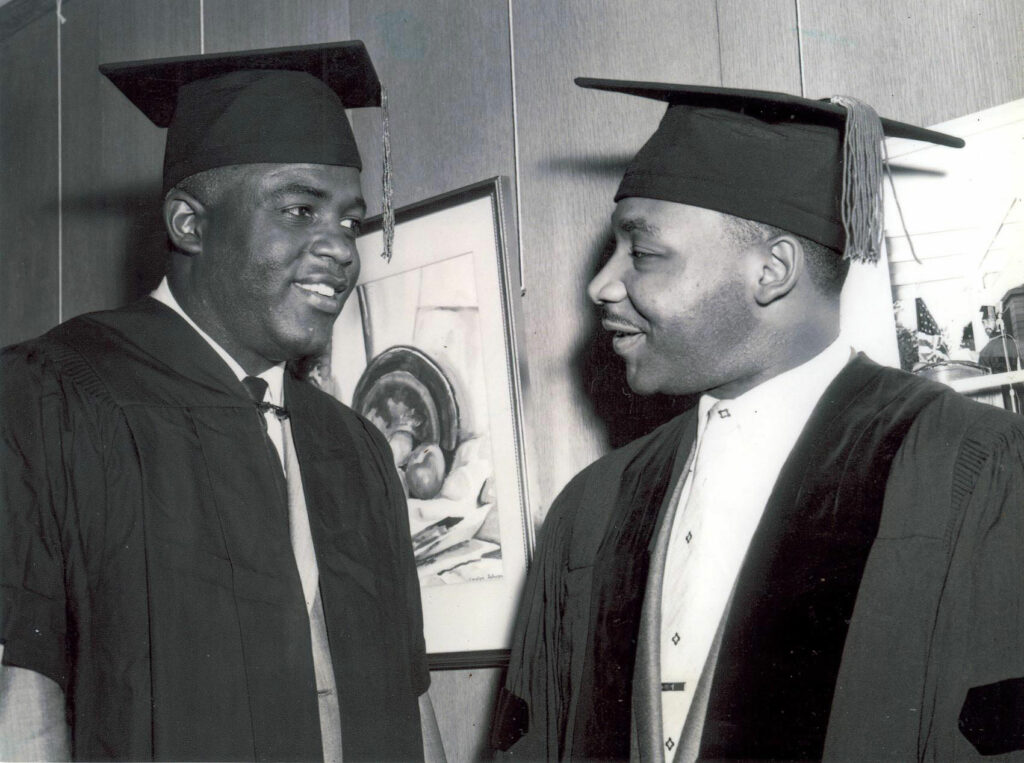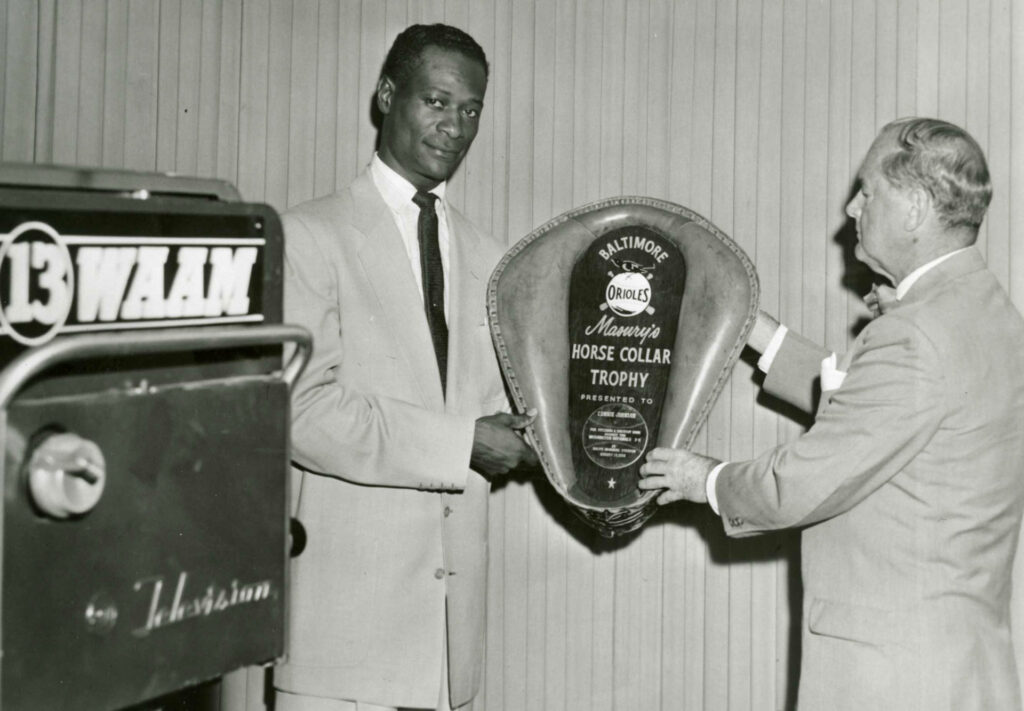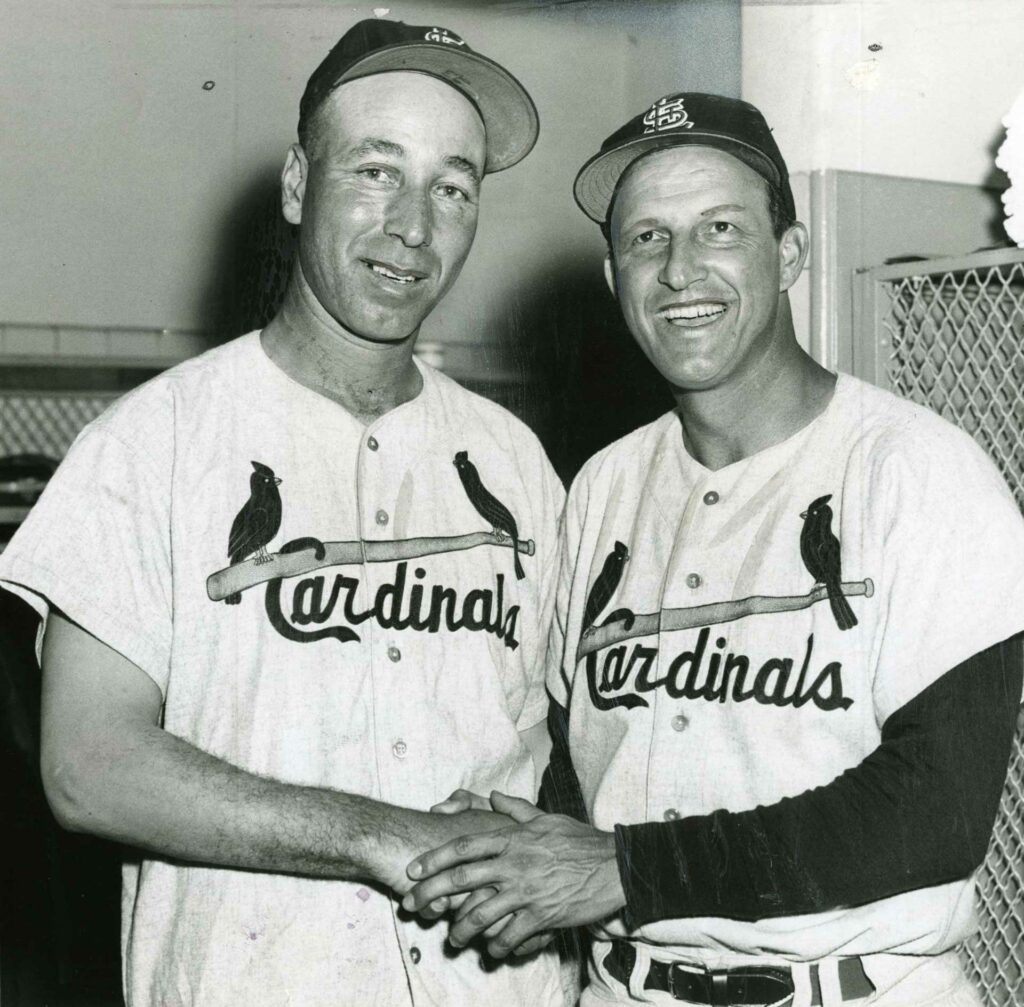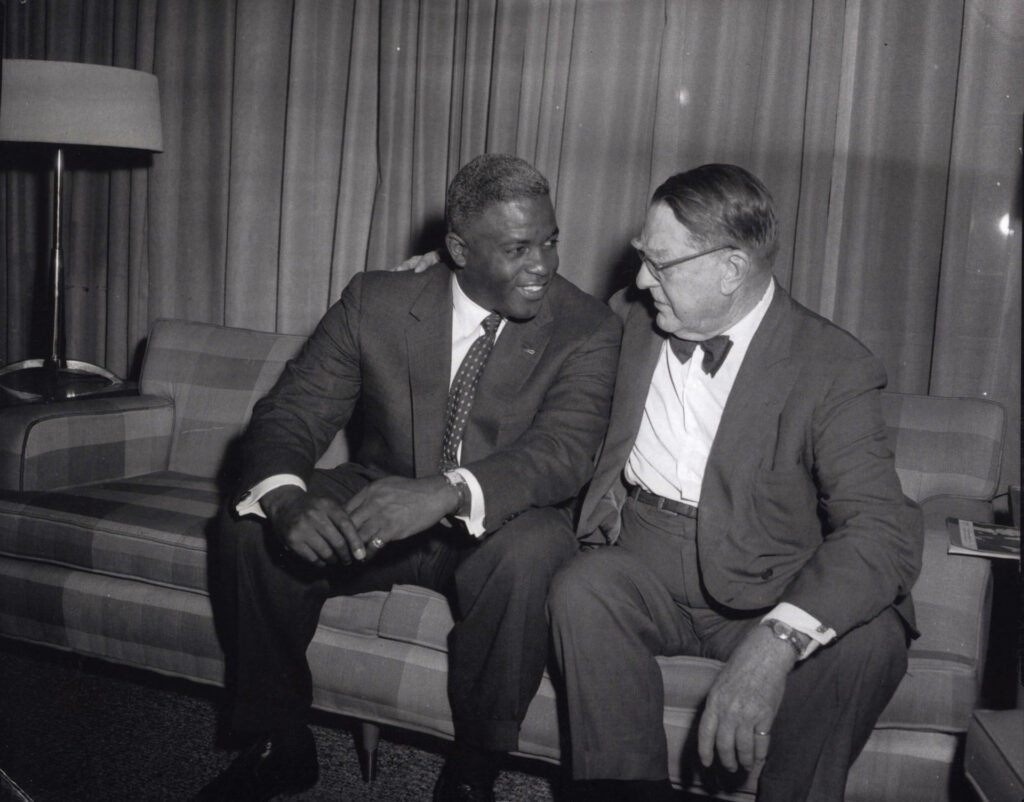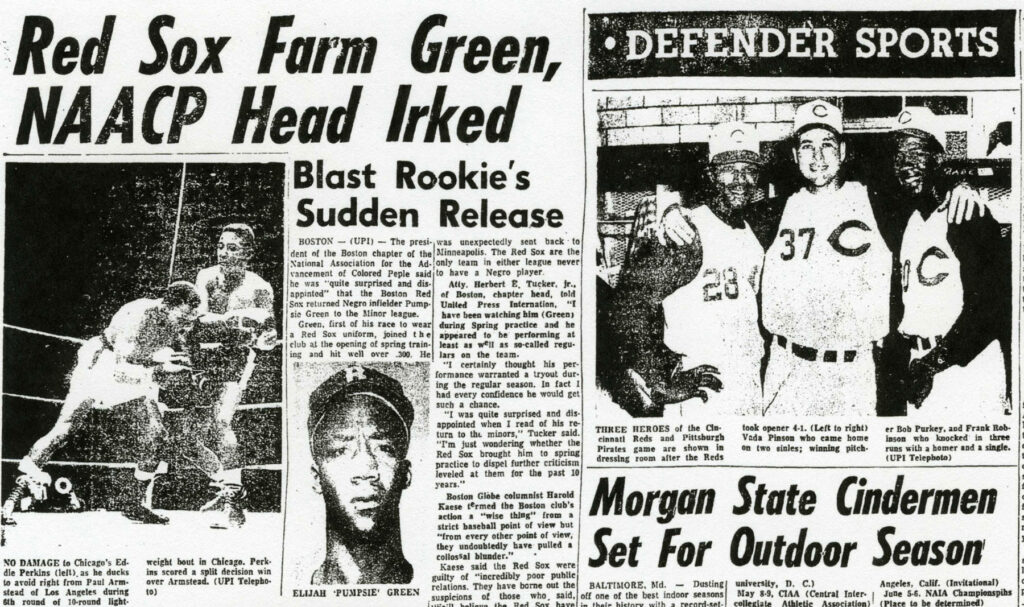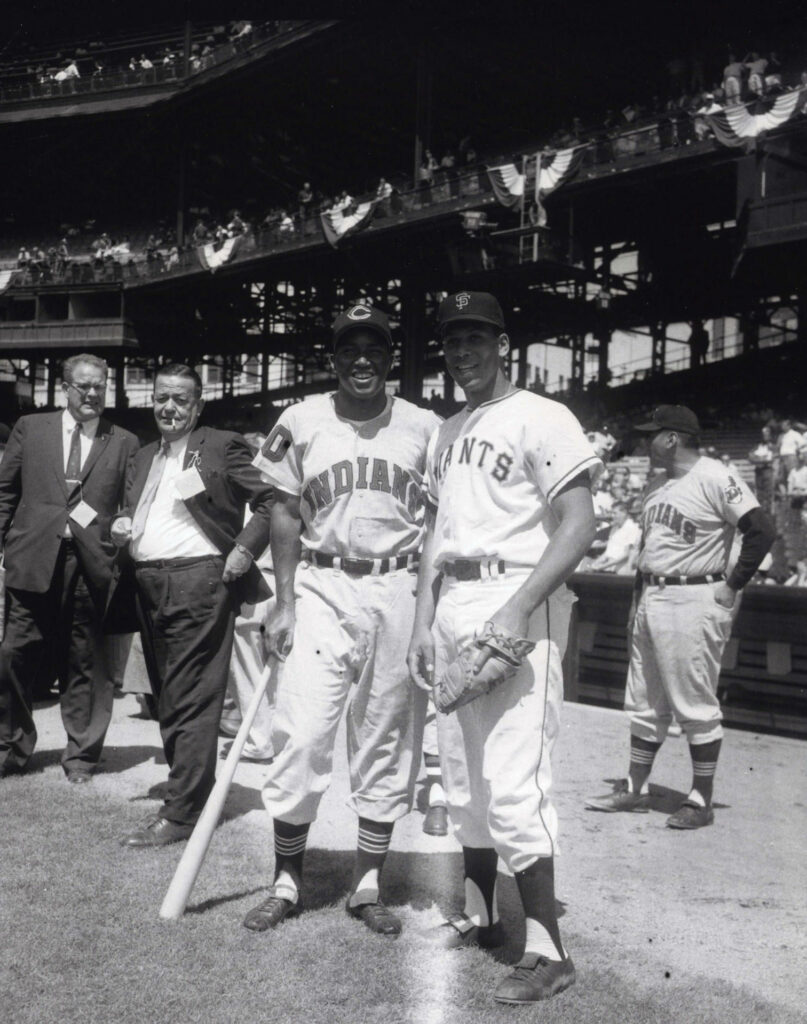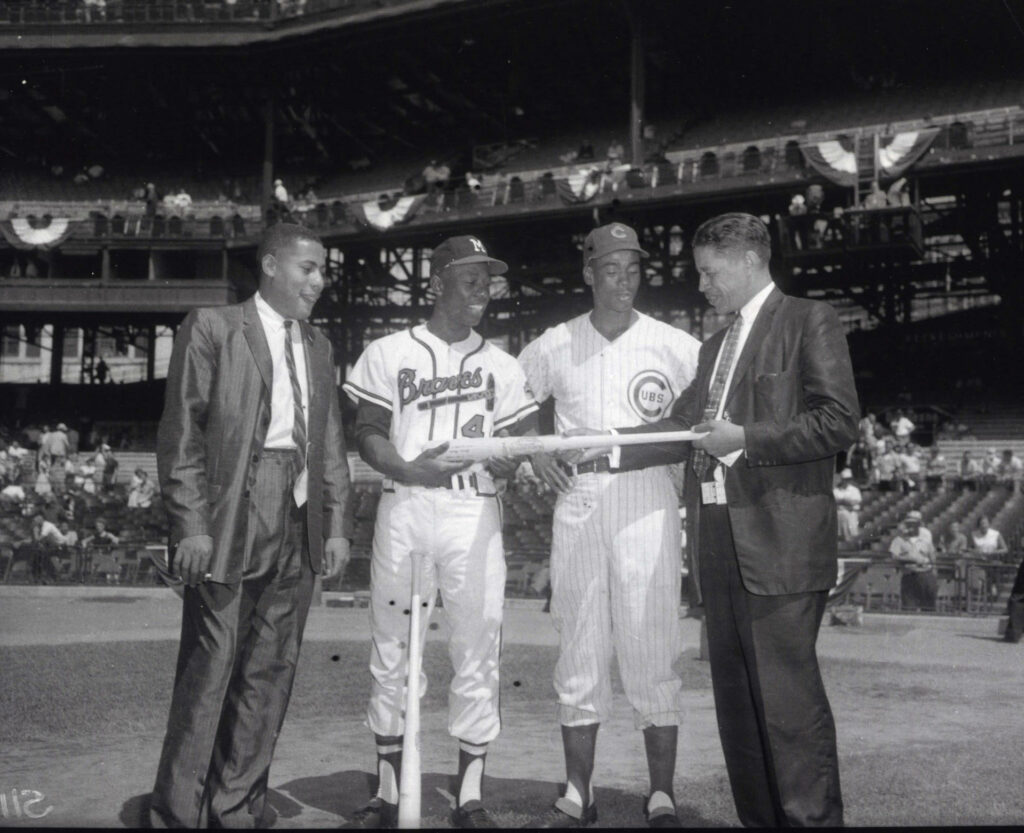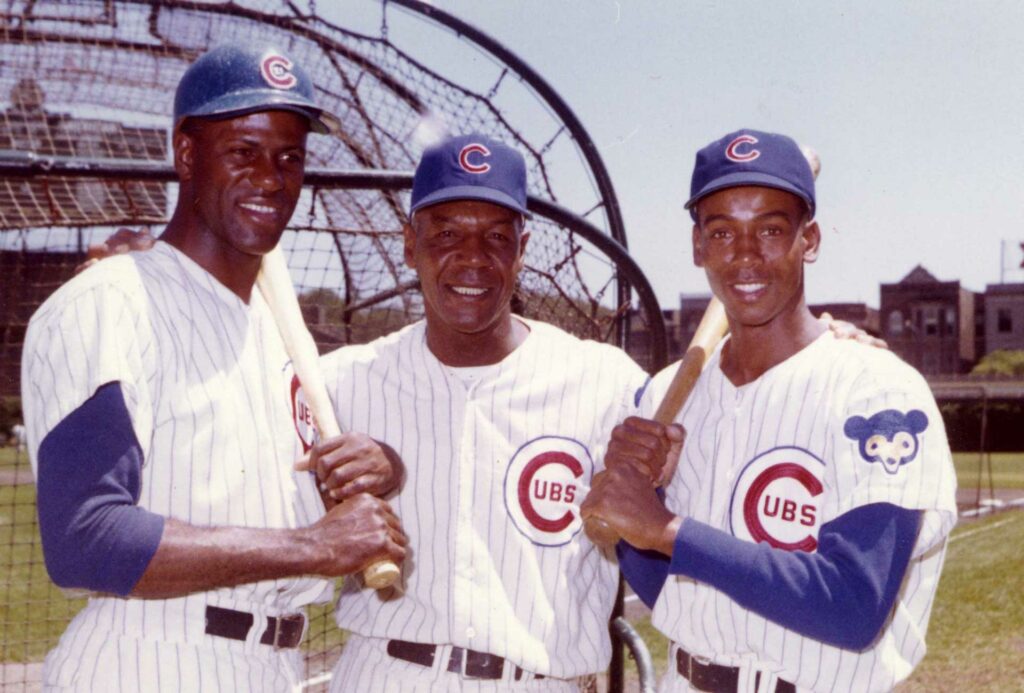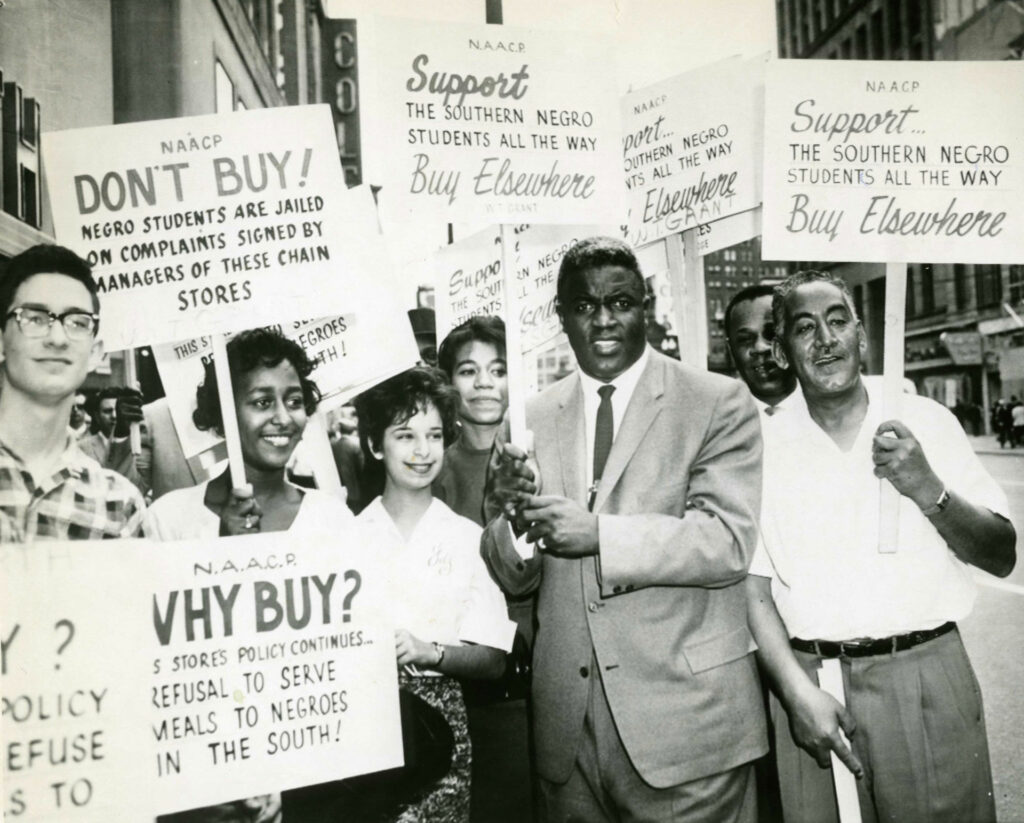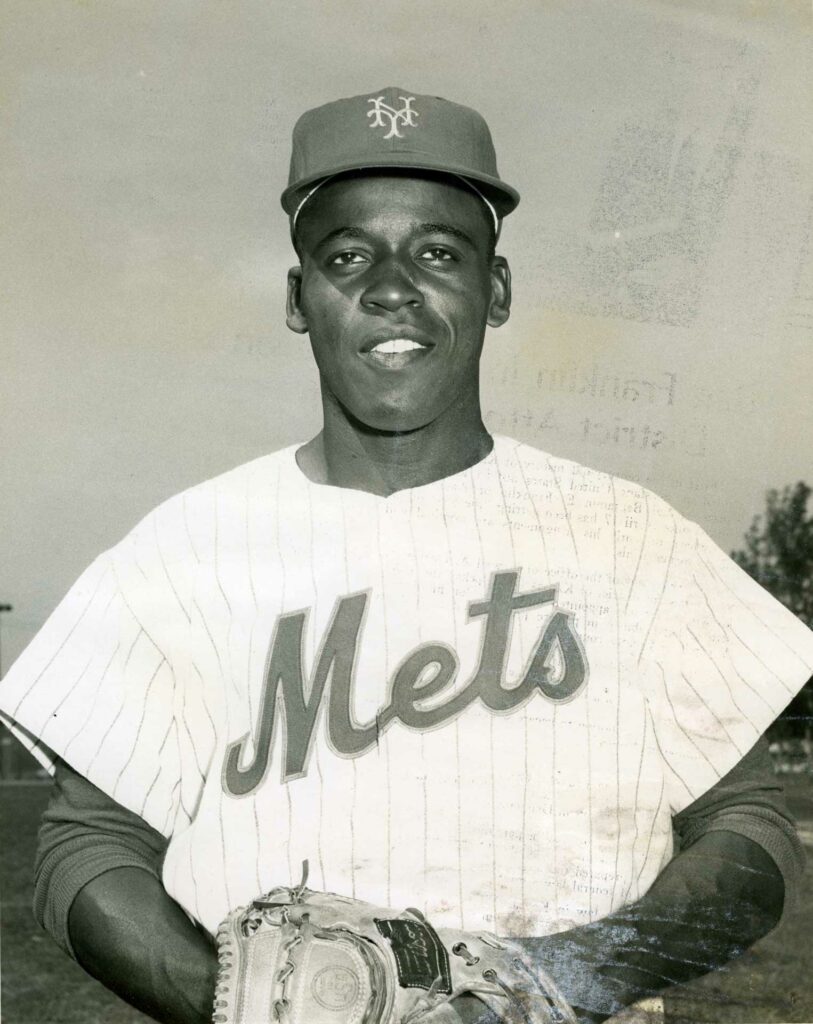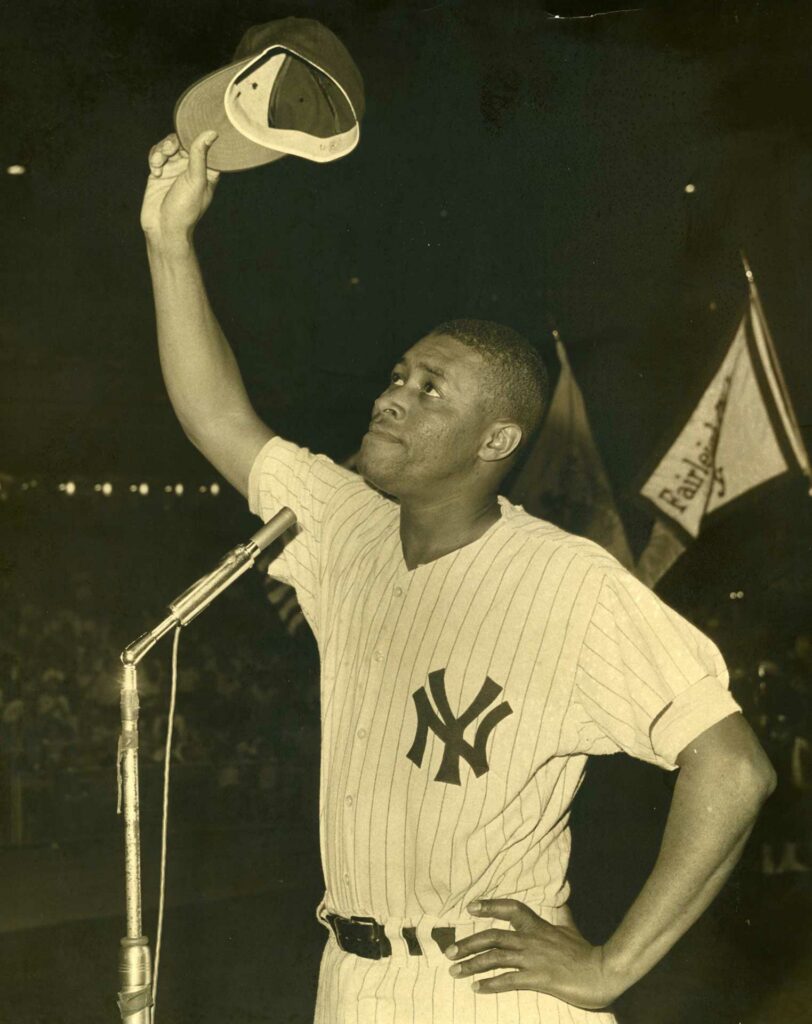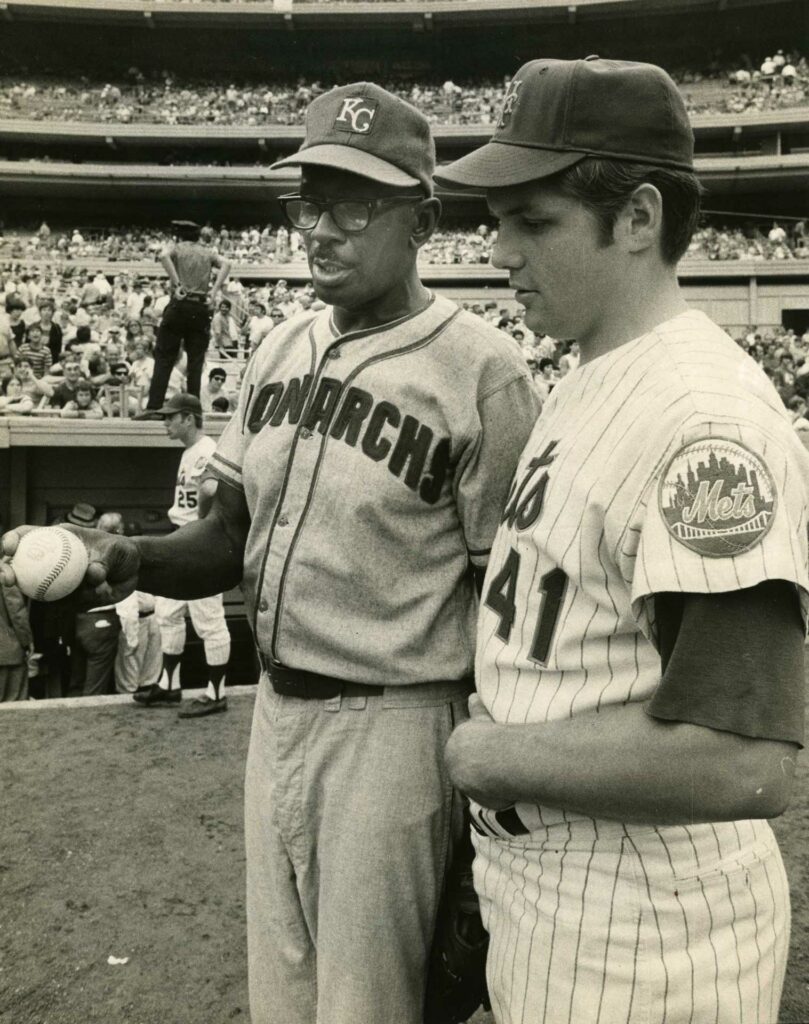1939–1945
Changing Times
World War II had a profound effect on the Negro Leagues. Defense plant jobs with higher wages also improved the economic conditions of black patrons, leaving more money for activities such as attending baseball games. During the war, more than 50 Negro Leagues players served their country in the Armed Forces. Younger players were drafted into the military, making room for other players to replace them. Yet, many older players were not drafted, including many of the top league stars. They drew large crowds where they played. The success of the Negro Leagues caught the attention of fans, managers, and owners of Major League Baseball teams.
Activists’ demands for equality in baseball did not go unnoticed. By the end of World War II, there were political investigations into baseball’s hiring practices, petitions circulated by citizens, and campaigns taken up by sportswriters challenging segregation in baseball.
BUCK LEONARD WITH FANS: Homestead Grays star first baseman and leader Walter “Buck” Leonard poses with baseball fans after an August 1939 All-Star game at Yankee Stadium, New York. This was a second All-Star game held that year, with the traditional location of Chicago’s Comiskey Park hosting earlier that month.
1944 NEGRO LEAGUES YEARBOOK: The annual end of the season baseball publication highlights the irony of segregation in baseball during World War II. Homestead Grays player Earnest “Spoon” Carter is featured on the cover. Many baseball players from the Major Leagues and Negro Leagues were drafted or joined the military during World War II. However, a deeper pool of talented players remained in the black baseball leagues than in the Major Leagues. The talent and sacrifice of African American soldiers brought great attention to issues of integration.
EARLY JACKIE: Jack Roosevelt Robinson excelled at many sports in his youth and in college. Among them was collegiate football. In 1940, he was an offensive and defensive star for the UCLA Bruins. He was drafted into the Unites States Army during World War II. He was stationed at Fort Riley, Kansas, where he successfully fought to enter Officer Candidate School. Reaching the rank of Lieutenant, he would be assigned to Fort Hood, Texas. Robinson was victorious in a court-marshal hearing where he was accused of insubordination involving a dispute on a public bus. Robinson never saw combat and was honorably discharged in 1944.
MICKEY TABORN: Earl “Mickey” Taborn was born in central Illinois, but baseball took him to other parts of the world. He lived and played baseball in St. Louis for many years before being drafted into the Army. He would join the Kansas City Monarchs in the mid-1940s as a star catcher and briefly had a minor league stay in Newark. Baseball eventually took him to Mexico and the Caribbean, where he had a long, distinguished career for several teams.
MAX: Maxwell “Max” Manning had his pitching career with the Newark Eagles interrupted by Air Force military service in the U.S. and Europe from 1942-1945. However, he returned in 1946 in time to help the Eagles win the Negro Leagues championship. He would later excel in Mexico, Cuba, and the Caribbean before a heading to Canada in the early 1950s. After baseball, he completed his education and became a teacher.
BUCK: John “Buck” O’Neil left his role at first base for the Kansas City Monarchs to join the Navy, where he served in the Philippines. Her returned to baseball in 1946 in Mexico before rejoining the Monarchs, continuing his run as a star player and team leader. He eventually became the team’s manager in the late 1940s-early 1950s.
1946
A New Era
From 1947–1959, close to 120 African American and Afro Latino men endured the grueling process of integrating Major League and Minor League baseball organizations throughout North America. It took those 12 years for every Major League team to have at least one minority team member. Larry Doby, Hank Thompson, Willard Brown and Dan Bankhead immediately followed Jackie Robinson in 1947. Many encountered the same, if not worst, hardships as Jackie Robinson. In the process, they flung open the doors of inclusion to everyone in their respective communities. Many learned their skills in the Negro Leagues, and among them are some of the greatest players ever—Hall of Fame inductees and award winners. All are baseball pioneers.
MacPHAIL MEMORANDUM: A commission was formed in the early 1940s by Mayor Fiorello LaGuardia on the issue of integrating baseball in New York City. Larry MacPhail, managing partner of the New York Yankees Baseball Club, outlines to the commission his opinions on why integration would be wrong for baseball.
SEE MORE IN THIS SERIESJOHN WRIGHT: Among the many noteworthy sports items in the February 9, 1946 edition of The Chicago Defender Newspaper was the story of New Orleans-native John Wright, in the article, “Second to Sign.” A star pitcher with the Homestead Grays team, Wright was recruited by the Brooklyn Dodgers to join Jackie Robinson at Montreal in the minor leagues. Wright struggled in minor league baseball, but had a successful return to the Negro Leagues in 1947 before retiring from baseball.
SOUTHERN RESISTANCE: The March 23, 1946 New York Times reports from the Associated Press that the Montreal Royals had their spring training game canceled by local officials in Jacksonville, Florida. Segregation laws were cited because John Wright and Jackie Robinson, two black ballplayers, were with Montreal, the Brooklyn Dodgers minor league team.
JOSH GIBSON PASSES AWAY: All-Star catcher and slugger Josh Gibson began experiencing health issues in the early 1940s and had to stop playing by 1946. He passed away in Pittsburgh on January 20, 1947, at age 35. For his 16 seasons in the Negro Leagues and Latin America, he was considered by many to be the among the best players in baseball history.
1947
The First Season
A war weary world continues to see conflicts in Africa, Asia, and the Middle East, while freedom struggles for people of color persist in the United States. However, what seemed to be comparatively minor occurrences in world events raised the profile of the fight for equality in America. Major League Baseball would admit African American athletes to compete for the first time since the late 1800s. The slow process of integrating America’s favorite spectator sport began with five players that first season.
LEADERSHIP CRISIS: Brooklyn Dodgers General Manager Branch Rickey (seated at desk) and manager Leo Durocher (left next to Rickey). address the media after his suspension for the 1947 season by Commissioner of Baseball Albert “Happy” Chandler. Durocher was penalized for associating with known gamblers. He was thought to be an advocate for the integration of the Dodgers, and his suspension could hamper the experiment. However, interim manager Burt Shotton stepped in to lead the Dodgers to win the National League pennant.
JACKIE ROBINSON & DAN BANKHEAD: Former stars in the Negro Leagues, Jackie Robinson and Dan Bankhead integrate Major League Baseball with the Brooklyn Dodgers. Robinson made his historic debut in April 1947, while Bankhead, who played with the Memphis Red Sox in the Negro Leagues, joined in September as the first Black pitcher in Major League Baseball. Robinson ended the season as Rookie of the Year.
LARRY DOBY & BILL VEECK: Former star of the Newark Eagles Larry Doby is greeted by pioneering Cleveland Indians owner Bill Veeck, who recruited him for his team in 1947. Forgoing time in the minor leagues, Doby played in his first Major League game on July 5, becoming the first Black player to integrate the American League.
THOMPSON & BROWN MAKE HISTORY: This clipping from The St. Louis Argus newspaper on July 18, 1947 shows former Kansas City Monarchs players Henry “Hank” Thompson and Willard “Home Run” Brown signing contracts with the St. Louis Browns in the American League. Their time in St. Louis was short, as Thompson eventually was traded to the New York Giants, and Brown returned to the Negro Leagues.
1948–1950
A Bittersweet Ending
Television began its rapid expansion in the United States, offering news, presidential election coverage, entertainment, and sporting events to the masses. The integration of baseball, however, was still a slow moving process. There were five black players to join Major League teams in 1947, but only seven total in the period between 1948–1950. Among this seemingly small number were some of the great stars from the Negro Leagues.
CAMPY: Baltimore Elite Giants catcher Roy Campanella was being scouted by the Brooklyn Dodgers along with many other Negro Leagues stars. He and pitcher Don Newcombe were signed and eventually assigned to the Dodgers minor league team in Nashua, New Hampshire. He made his Major League debut in 1948, beginning a Hall of Fame career.
ALL STARS: In 1949, for the first time in Major League history, African American players play in the All-Star Game. The game saw Larry Doby for the American League joined by Roy Campanella, Jackie Robinson, and pitcher Don Newcombe for the National League. The All-Star game was held at Ebbets Field.
GIANTS IRVIN AND THOMPSON: Former Negro Leagues star Hank Thompson was traded from the St. Louis Browns to the New York Giants where he joined another former Negro Leaguer, Monte Irvin. In June of 1950, they celebrate postgame as they defeated the Cincinnati Reds 12-2 on 7 home runs hit by this group. From left, Irvin, Wes Westrum, Whitey Lockman, Thompson, and Alvin Dark.
1951–1953
Their Prominence Grows
With African American and Afro Latino players establishing themselves as valuable contributors in Major League Baseball, the early 1950s proved be to a robust period for recruitment and the inclusion of athletes of color at the top levels. Twenty-six players entered the major leagues including two future Hall of Famers, Willie Mays, Henry Aaron, and Ernie Banks.
1954–1956
Rapid changes face the country and America’s pastime. Baseball teams begin to realize the benefits of tapping into the growing talent pool of African American and Afro Latino baseball players. As the Negro Leagues began to decline, it was also developing talent for Minor League and Major League teams. Close to 40 players helped to integrate baseball in this period and included some of the most significant players to debut.
1957–1959
Despite many racial disparities and social conflicts in the United States, players of color were becoming well established in Major League Baseball. In this period, 38 players help complete baseball’s integration, where every team has at least one African American or Hispanic player.
PUMPSIE: Elijah “Pumpsie” Green got off to a rocky start as the first African American player for the Boston Red Sox. Boston was the last team to integrate. The April 18, 1959 Chicago Defender newspaper reports on the Boston NAACP’s opposition to his minor league assignment. He eventually joined the Major League team in July.
1960–1975
Legacy
Through the turbulent days of the 1950s and 1960s, many African American baseball players took their places among the list of the greatest athletes of all time. Their influence on the game was profound. The number of players was reaching all-time statistical records, while slowly moving into leadership positions as coaches and managers. By 1970, nearly 15 percent of MLB players were African American.
SUPERSTARS: Former Negro Leaguers Henry Aaron and Willie Mays are established longtime superstars in Major League Baseball, now playing with the Atlanta Braves and New York Mets in the early 1970s. Aaron and Mays would hit 755 and 660 home runs, respectively, and both would achieve more than 3,000 hits during their illustrious careers.
